by Nic Haygarth | 17/06/23 | Tasmanian high country history, Tasmanian nature tourism history
While walking the Overland Track between Cradle Mountain and Lake St Clair in 1931, pedestrian extraordinaire ET Emmett found some words scribbled on a pine rafter inside the old mine workers’ hut at Pelion Plain.[1] The scribble authors, Emmett wrote, were ‘members of Mr Jocelyne’s [sic] South African party’, who had recorded details of their seven days’ stay in the area:
‘Scalps taken: Mt Oakleigh, Mr Ossa, Lake Ayr, Mt Thetis, Forth Gorge, Toad Rocks, Pelion East’.[2]
The Joscelyne in question was probably Horace Joscelyne (1878–1965), a Launceston-born grocer’s assistant who visited Cradle Mountain in 1922.[3] But who were the South Africans? Perhaps Horace and his wife Addie showed Tasmania to some South African visitors. Emmett’s 1931 Overland Track party was guided by temporary park ranger Bert Nichols, but the Joscelyne tour was probably from the time of Nichols’ predecessor as highland tour guide, Paddy Hartnett.
The Fred Smithies papers in the Tasmanian Archives[4] contain what is probably a semi-fictional account of the Joscelyne trip with Hartnett. Most of the same ‘scalps’—Mounts Oakleigh, Ossa and Thetis, Lake Eyre [sic] and ‘Pelion’s giant toad’—in the fictional account were ‘taken’ in similar order as outlined on the Pelion hut rafter. Although the story has a more linear structure than ‘A dip into the Waldheim mailbag’ (see earlier blog), it refers to the earlier story and appears to have the same anonymous author. As outlined in the previous blog, the author of the Waldheim mailbag story is likely to be one of Vera May Scott, Lydia Morrison or Addie (Harriet Mary) Joscelyne. It is unknown whether any of these women was a member of Horace Joscelyne’s ‘South African’ party. The candidates for authorship line up like this:
Vera May Scott (1886–1962)[5] was born at Battersea, London. At the 1901 British census she was a 15-year-old living in London with her 47-year-old piano tuner father Henry Sidney Scott and 37-year-old Brisbane-born mother May Scott.[6] No record of the family’s migration was found, but in 1922 Vera May Scott was an unmarried typist living at 28 Delamere Crescent, Trevallyn with her parents and sister Eleanor Scott.[7] Scott lived next door to the Joscelynes and had a strong connection to the family. In 1945 she thanked Horace Joscelyne for ‘unfailing kindness’ during her mother’s long illness.[8] Rupert William Joscelyne Hart, whom Scott recognised in her will, was the son of Horace Joscelyne’s sister Violet Mary Joscelyne.[9]
Lydia Morrison (1886–1971)[10] appears to have emigrated from England as a small child in 1891, along with her two-year-old brother and her parents, 28-year-old Lydia Morrison senior and 35-year-old farmer William Morrison.[11] In 1922 Lydia lived with her parents, her sister Dorothy Mary Morrison and brother William Morrison junior, at 211 St John Street, Launceston.[12] Forty-six years later in 1968 Lydia was still listed as an unmarried clerk—at 82 years of age—and living with her bookbinder sister at 6 Union Street, Launceston.[13]
Harriet (‘Addie’) Joscelyne née Cumings (c1872–1946) emigrated from England with her sister as a teenaged nursemaid in 1888. Her parents, Ebenezer and Caroline Cumings, had preceded her and were already Launceston residents.[14] Addie’s older sister Minnie gave her occupation in the passenger list as schoolteacher, and until her marriage in 1893 she operated the Trevallyn Preparatory School.[15] At this point Addie Cumings took over from her, continuing the school until at least 1897.[16] This suggests that she was at least reasonably well educated. Addie Cumings married Horace Samuel Joscelyne at Launceston in 1903. They had no children.[17]
When did the trip take place?
Details in the semi-fictional account allow us to arrive at a possible time for the trip on which it was based. It was undertaken when the waratahs were in flower, which makes it in the period October to December. The ‘mistress of the more pretentious hut’ mentioned in the text was Elizabeth Gregson of Gisborne’s Hut/the Mount Pelion Mines Hut. She was living alone, which puts the trip in a two-month window between the death of her partner John Gregson on 11 June 1926 and her admission to the New Town Charitable Infirmary on 5 August 1926.[18] This suggests a winter tour, a very unlikely scenario not only because of the weather conditions but because at this time Hartnett would almost certainly have been hunting out beyond Adamsfield. Clearly also this does not tally with the late spring/early summer appearance of waratah blooms! The fictional account contains a credible return visit to Gisborne’s Hut when Elizabeth was found to be ‘in most wretched and squalid sickness’, a ‘poor frail old form’ eliciting ‘a deep pity for all lonely bush women, and especially all sick ones’. This does suggest the type of situation in which the elderly widow would have been forced to enter the charitable institution. The writer has taken the liberty of moving Elizabeth Gregson’s last days of freedom into the late spring, a much more likely time for the Pelion excursion.
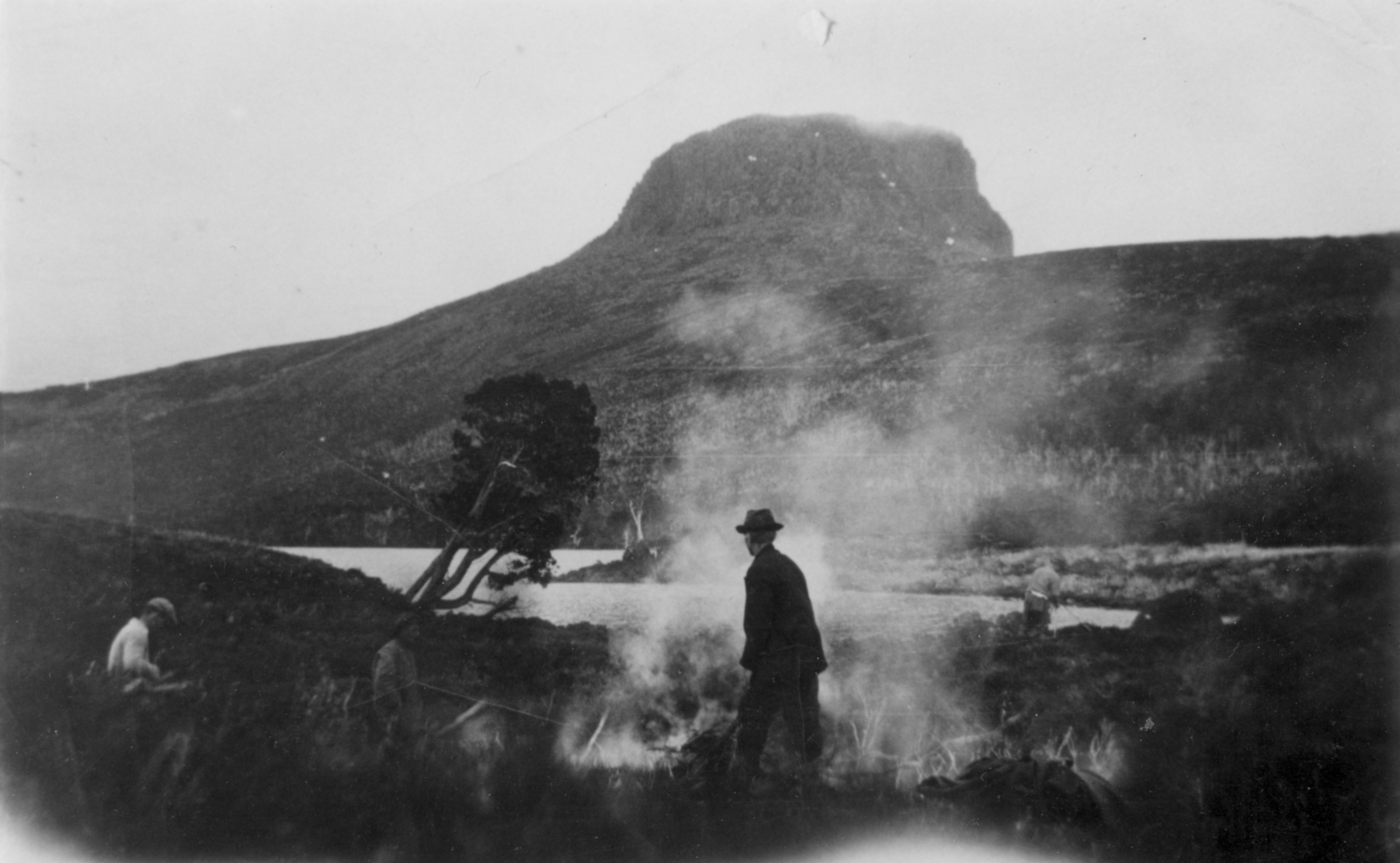
Paddy Hartnett burning off at Lake Will, with Barn Bluff in the distance.
Photo courtesy of the late Nell Williams.
What about the Waldheim component of the trip? A tantalising photo exists of Paddy Hartnett burning off grass at Lake Will, just off the logical route from Commonwealth Creek to Waldheim along the line of present Overland Track. The author of the semi-fictional Hartnett tour may well have climbed the Razorback on one of Hartnett’s real expeditions— yet in his diaries Gustav Weindorfer never mentioned a Hartnett party arriving at Waldheim from Commonwealth Creek via the Razorback Track.[19]
Leaving aside the matter of whether Hartnett ever brought a party to Waldheim via Razorback, there is evidence in the fictional account to suggest that the author either did in fact make a second trip to Waldheim or was very well informed about changes to that establishment. In her fictional account she mentioned seeing white pegs while rounding the western side of Cradle Mountain. These were possibly placed there by Weindorfer in April 1922 when he was engaged to mark or cut a pack-track from Waldheim to the Barn Bluff mines.[20] The writer mentioned a new woodshed and a ‘tent room’ at Waldheim. These were built 1923–24.[21] Weindorfer’s dog Flock was still alive at the time of the fictional visit—she died on 4 January 1927. Weindorfer was absent from Waldheim from 2 July to 13 November 1926, so he could not have met the timeline suggested by Elizabeth Gregson’s widowhood and removal from Gisborne’s Hut.[22] Puzzlingly, Weindorfer’s diaries contain no reference to Vera Scott, Lydia Morrison or the Joscelynes putting in another appearance at Waldheim after 1922. However, the Joscelynes were friends of Weindorfer whom he visited in Launceston in 1923 and 1926, and it is possible that the anonymous author (particularly if it was Vera Scott, who lived next door to the Joscelynes) was included in these visits and used these to update her knowledge of Waldheim.[23]
Most of ‘A dip into the Waldheim mailbag’ was written in character by Claudia Crane, who married at the story’s end. This time it appears to be her cousin Mona Moore’s turn, although the only names used in the later account are ‘Paddy’ and ‘Percy Lane’. Not even ‘Mine Host’ of Waldheim is actually named. Percy reappears at the end of the epistle to rescue the hospitalised Mona, who has been recalling her trip with Hartnett in the great outdoors as an antidote to the walls of the institution. Since writing a letter for the Waldheim mailbag, Mona has developed a staccato-style of writing with a fondness for the exclamation mark, as if to emphasise her girlish high spirits..
The account
My dear memory Pictures; How I have loved them and lingered over them in these long weeks of imprisonment! How often as I lay here the hospital walls have faded away and great trees have tossed their heads far above me. Once again I and my trusty comrades have tramped ankle-deep in the fragrant lemon thyme [sic], or scrambled happily among the giant boulders on the top of the world. Those long yet all too short days of happy comrade-ship; [sic] the unexpected meeting with our old friend Percy — the glad gathering up of the threads of old time friendship — the intimate talks on every subject under the sun — How I have lived it all over and smiled and sighed over my pictures! Just this once I am going to allow myself to glance at them all again, and then to work!
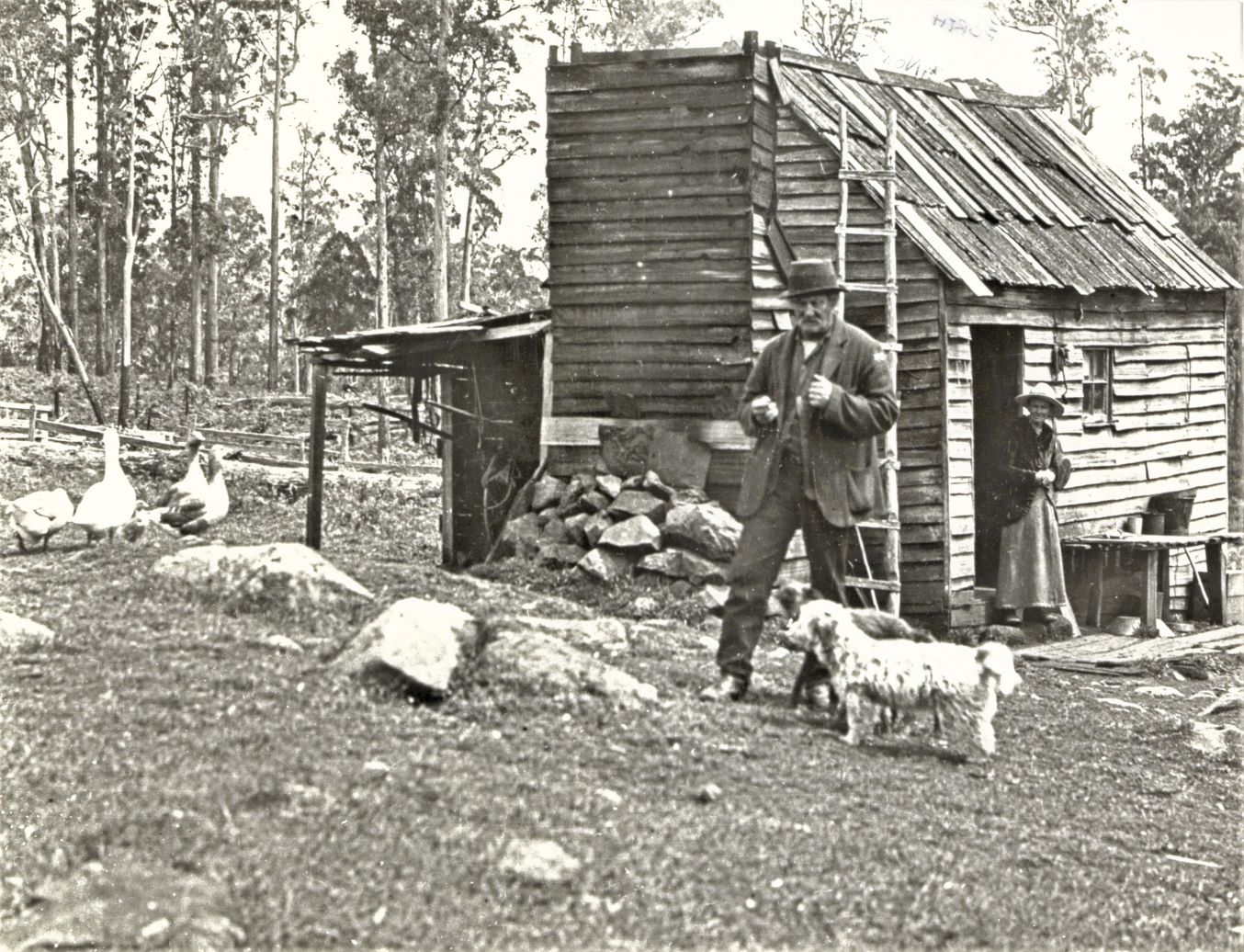
John and Elizabeth Gregson at Gisborne’s Hut in 1921. Fred Smithies photo, NS573/4/4/55 (TA).
A rolling green slope, hemmed in on all sides by great trees and roofed by the spacious sky. A streamlet purling past two little grey huts sleeping in the drowsy sunshine of a peaceful Sabbath afternoon.[24] A queer ramshackle vehicle toils up the slope and the peace is broken by a little party of Townies. The mistress of the more pretentious hut is a little wiry, shrivelled figure sharp of voice, but ready of smile and disposed to be friendly.[25] She soon has the feminine portion of the party ensconced on her doorstep listening to the finest entertainment she can offer — her gramophone. The entertainment is shared with dogs of all shapes and sizes, but alike in one respect, they are all the proud owners of a coat of thickly matted hair and buzzies. Troops of kittens tumble round but at the slightest movement in their direction they disappear under the house with the unanimity of well-trained soldiers.
As evening approaches the upper hut buzzes with life —the Townies are busily engaged settling in for the night. The wooden chimney proves to be well furnished with holes which admit the evening breezes, the said breezes being frolicsome blow clouds of smoke into the eyes of two busily making toast on forked sticks. The little breezes laugh to see a handkerchief cautiously removed to allow of lightning inspection of the toast and then as quickly replaced over aching streaming eyes. There were no regrets when that fire was allowed to die out.
Early morning sweet and fresh! Goodbye! Cavalcade sets forth led by the laden pack horses. Most inexperienced horse-women jogging gently along the beautiful winding path, filled with the deep quiet content of anticipation. The Forth gleams far below — now hiding — now shyly showing its beauty — the glint of the sun bringing out the warm tints of the mineral charged stones paving the clear stream. Presently the horse-women are footwomen by turns with a lame horse limping pain-fully [sic] behind. The pack horses far ahead — hot sunshine streaming down — Footsteps lagging a little.
****
Cool running water — Great trees offering its [sic] services as bridge — at long last the sight of a fire crackling away in the centre of the road! Pack horses minus their loads! Billy boiling! Glorious sense of restfulness pervading every inch of tired limbs stretched out on the cool grassy road. Tea! Lots of it, deliciously hot and wet! A chop, minus salt! A little bag of potatoes doing duty as a table! Our cutlery, a stick and occasional use of a penknife. But no more delightful meal was ever served. More delicious rest on the gently sloping road-side, [sic] now the useful bag of potatoes acting as a pillow. Hands clasped under head (but removed at intervals for vicious swoops at the myriads of droning blowflies floating round.) Eyes gazing dreamily into the smiling blue sky, or lazily following the movements of a tiny fluffy bird hopping and chirping in the feathery grey-green of the young wattles.
****
On once more through beautiful fens and foliage over a narrowing track, the Forth, friendly as ever, still keeping us company. At length, a steep track zigzagging up the hillside, the towers of Mt Oakleigh keeping guard above.[26]
Horseback becoming dangerous, we stiffly dismount and, seated on the rocks of the pathway, gaze with huge respect at the great towers above little thinking that before many hours have passed we will be enthroned thereon, peeping over the edge at our present lowly seat.
Through the Valley of Eden, across the flower-decked plains and, bathed in the lovely evening lights, we have our first glimpse of the circle of guardian mountains which ere long have become such familiar friends.

Pelion Huts in 1931, looking north, with Mount Oakleigh as a backdrop. Jack Thwaites photo, NS3195/2/1588 (TA).
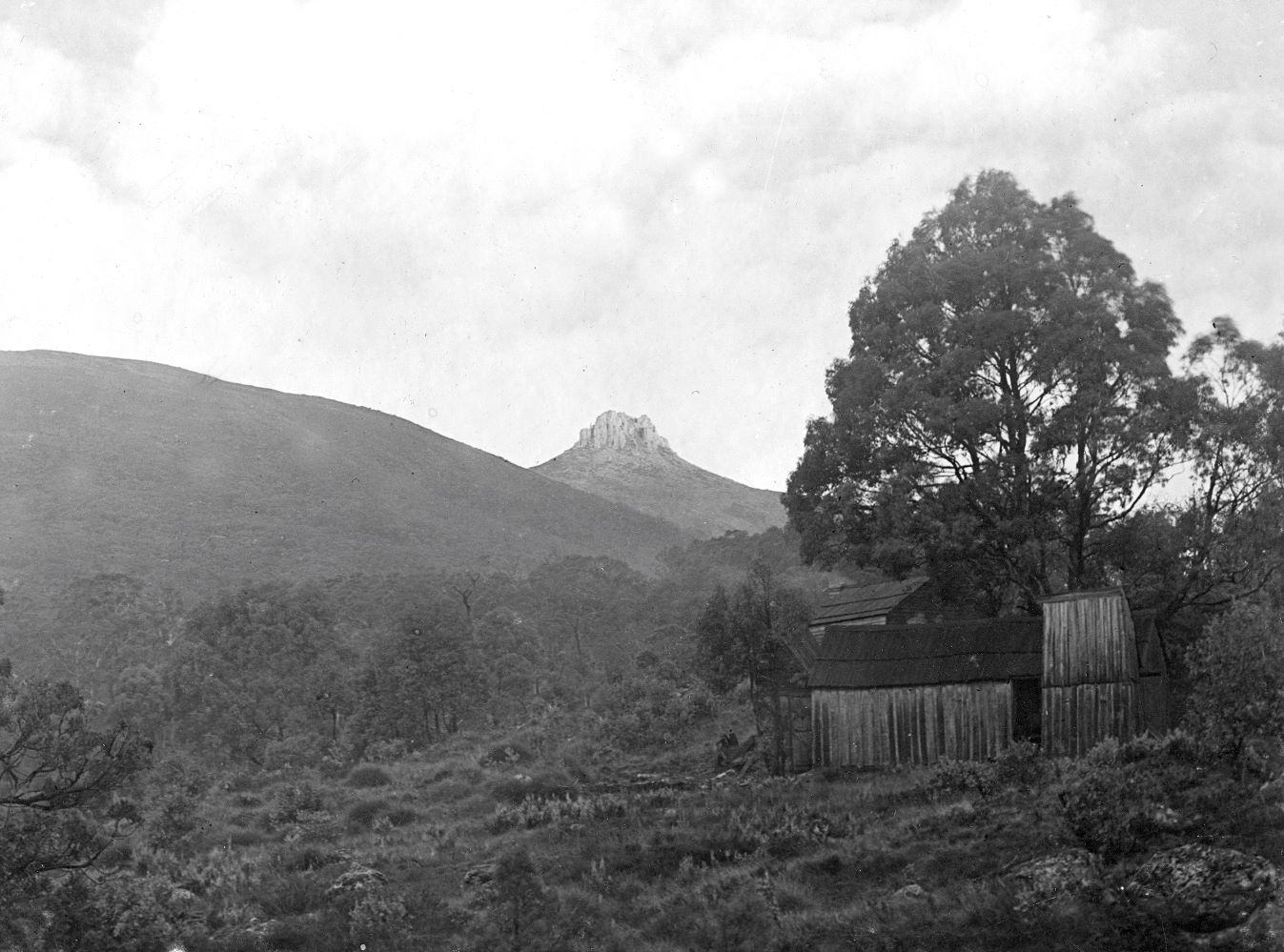
Pelion Huts looking south towards the Sugarloaf and Mount Pelion East, 1920. HJ King photo courtesy of the late Daisy Glennie.
Over the quaintest little bridge, walking on one log and clinging to another — and we are at Pelion Hut — our best loved home! In the next few days what expectant eyes it saw open on the light of a new day! What happy adventures fared forth from its portals and what tired, contented wayfarers returned at eventide!
At first we are a little put to it for lack of utensils, but as the days glide by we are the proud owners of a fine array of jam and fruit tins, which obligingly do duty as jelly molds, saucepans and all manner of things. The boxes in which our groceries were packed are just as obliging, three of them doing duty as table and the remainder as chairs.
Each morning as soon as breakfast is disposed of all are busy as bees preparing for the day’s adventure. On the table appears sundry little screws of paper containing salt, milk, powder, and tea etc; a tin of sugar, a mug of butter; the billy is packed with cups and the whole is soon transferred to the pack on Paddy’s back and off we start on the day’s tramp, cheered by the willing service of our old friend ‘billy’ and his busy little cousin ‘fizz’. When darkness falls, tired, sometimes wet, but happy, our hut sees us once more.
How bright and warm it grows under the combined efforts of huge fire, bicycle lamp, and candles stuck on tin lids. In a very few minutes the billy is boiling, the table fished from under the bunk and put together and the cloth laid (that cloth latterly of serviceable khaki relieved by small irregular splashes of white.)
Our centre piece is a paper serviette and a beautiful bouquet of Waratah [sic], ferny fronds, and graceful foliage, glorifies an empty jam tin given the necessary height of dignity by a pedestal of two tins of fruit. Our sugar basin is strangely like a mustard tin, the salt cellar strongly resembles the lid of that same tin, and they keep company with a most motley array of china, aluminium and enamel ware but we have a real teapot and a net milk jug cover, so what would you?
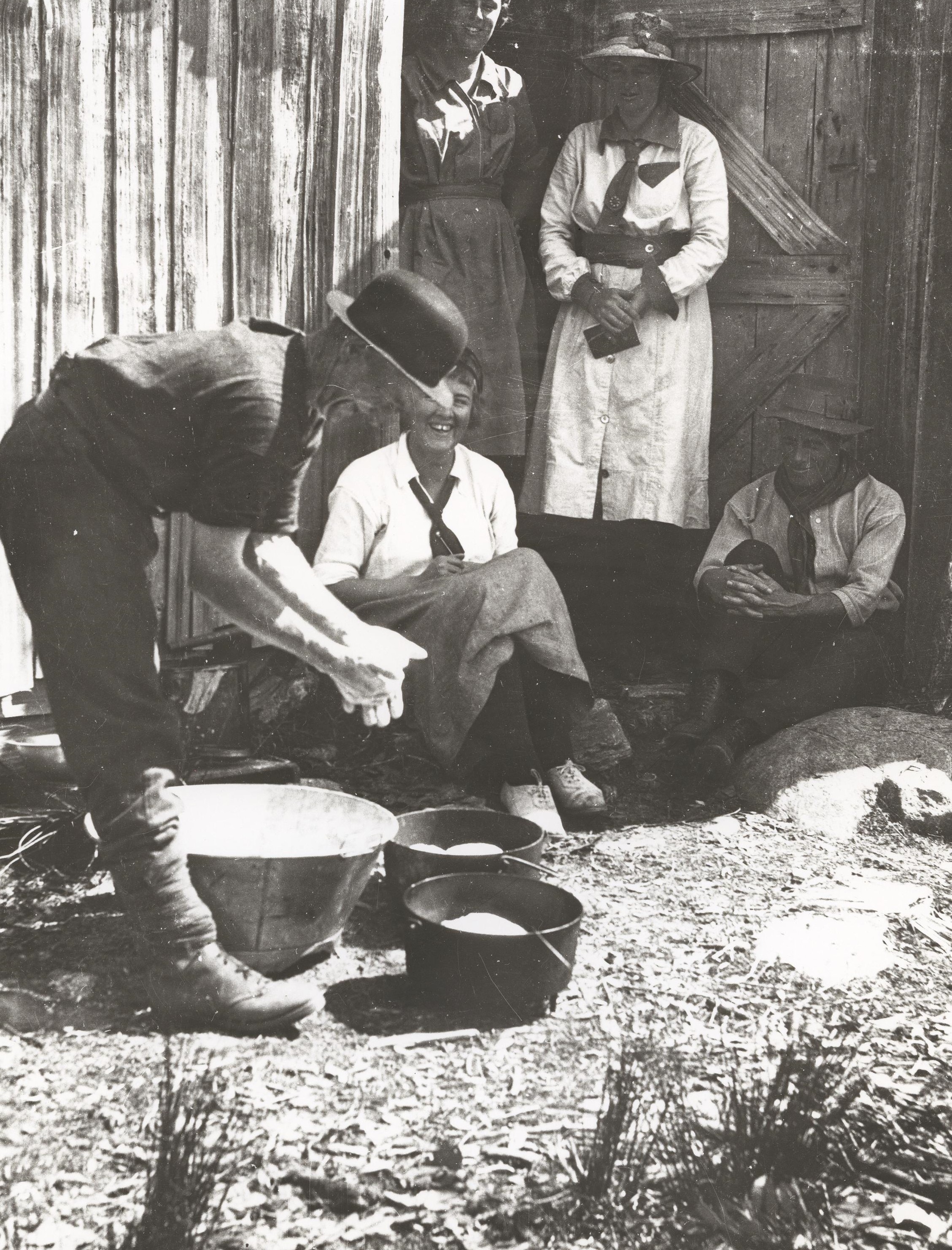
Hartnett (foreground) making damper, Pelion Huts, 1921, with (left to right) Florence Perrin (?), Edith McClinton (background in doorway), Ida Smithies (?) and George Perrin. Fred Smithies photo, NS573/4/4/1/36 (TA).
With what content we sit down to the well earned meal and when the first keen edge of appetite has worn off, push our box seats back so that the bunk supports serve as back rests, and talk and nibble nuts and raisins. Then the table is cleared, dishes washed, occasionally Paddy makes bread or we are visited by a tourist couple from a neighbouring hut, then our boxes are arranged in a cosy circle around the big rugged stone fireplace and a pleasant medley of poems, songs, and chat follows. Sometimes by the combined efforts of the whole party the whole of a song is remembered but usually one or two verses more or less mixed suffice! Even our childhood hymns have their places.
Then appears at the feet of each a cup of steaming coffee. Paddy lifts off the camp oven, ashes are scraped off, the lid is lifted, a chorus of approving voices greets the perfectly baked bread; very soon after that we are in dreamland.
****
Struggling slowly and with many a rest over the flowery plains and up lower slopes of the first mountain Oakleigh — Pushing through shady leafy tangles of vegetation richly illumined by brilliant touches of Waratah in full bloom — On the summit at last gazing our fill from one vantage point — Then being led to another and another until happy hours slip by unnoticed — The leisurely return over the plain in the wanning [sic] light — The magic of the long dreaming rest on the shores of the lakelet faithful mirror of the pearly sunset tints of the sky — Backward glances of Oakleigh now deliciously purple — Until at last the voices of the prudent are heard urging haste and most reluctantly we rise and wend our way homeward.
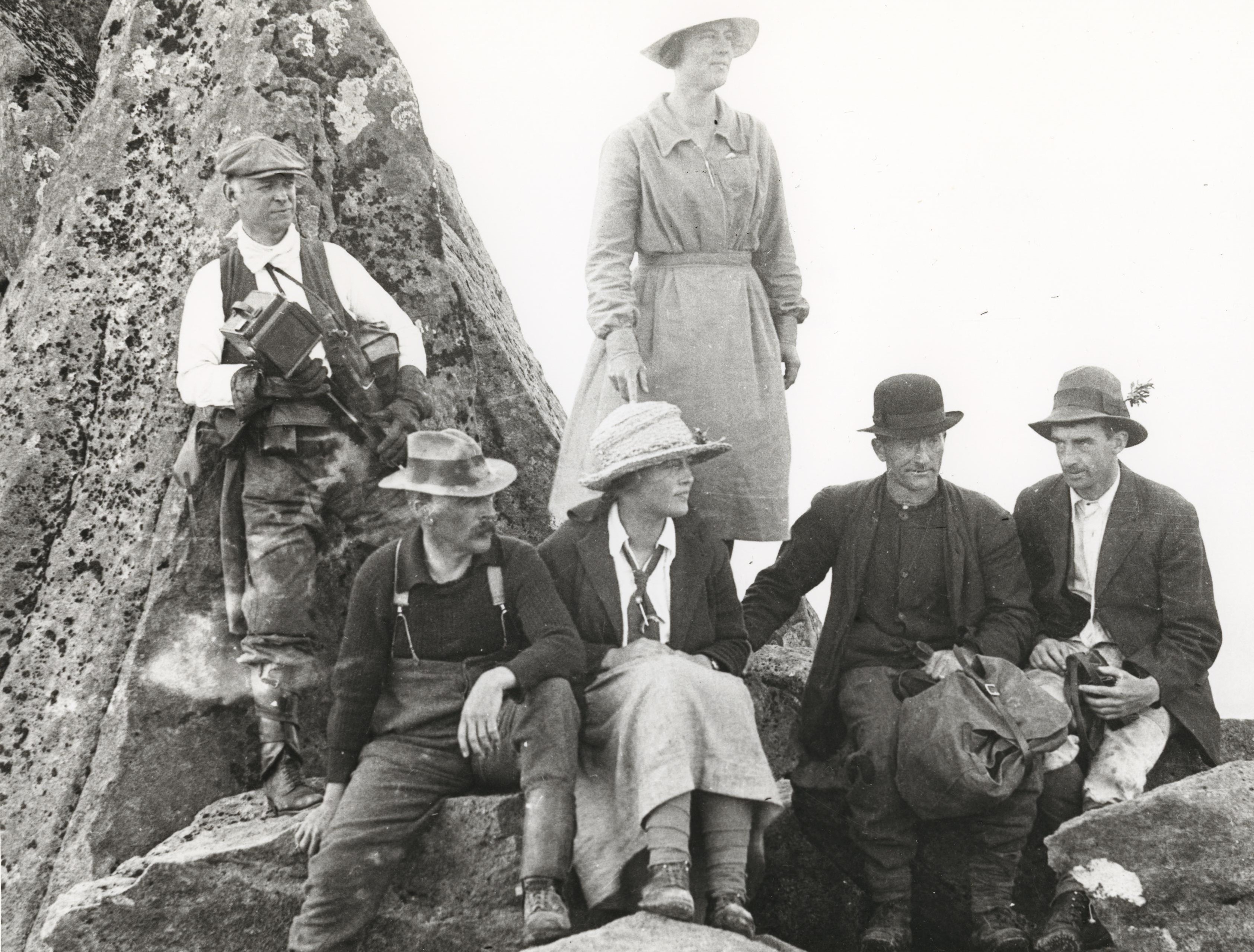
Paddy Hartnett (second from right) with a party on top of Mount Pelion West, 1921: (left to right) Ray McClinton, Frank Heyward, Florence Perrin, Edith McClinton and George Perrin. Fred Smithies photo courtesy of the late Nell Williams.
The swift rush of our descent from Ossa — The excitement of the rapid slides over the smooth snow heightened by the knowledge of great rocks and chasms and unknown depths below — Lowering ourselves cautiously down sheer drops with the friendly aid of the tough pineapple grass.
****
The rush up Thetis striving to race the driving mists to the summit — The biting wind which cuts into us whenever we come into the open — The grand piles of rock which we crawled or scrambled — The moments when we gazed helplessly at some huge heap and turned over for help that was never lacking — Places where the whole party hoisted us up or lowered us down some height — or where we walked up a ladder of human hands and shoulders. The foot reached at last in driving rain — We hastily prepared tea, cold and wet we sat down in one spot and carefully refrained from moving an inch from that partially dried and warm spot.
****
Lake Eyre [sic: Ayr] beautiful in the sunlight in its setting noble parklands. Paddy with an eye to next day’s dinner, leading gun in hand we followed in tip toe — picturesque glimpses of shy wild cattle — Tea interrupted by sudden rain — scuttle for shelter — two girls— lying flat one above the other squeezed beneath a fallen tree trunk — cosy intimate chat, eyes the while noting the lake dipling [sic, rippling?] and colour freshening on tree trunks and foliage under the rain — Contented, tramps round the lake and homeward single file in the gentle rain.
****
A leisurely stroll though plains thickly sprinkled with great daisies — where the plain ends, huge bushes of their smaller sisters greet us.
On we go up long easy slopes of springy green turf beautified by groups of large white orchids. Up here the Forth is young and frolicsome and dances gaily over little falls, turning and turning between beautiful pines that give it quite an alpine touch.
But we have a thought for tomorrow’s dinner despite the beauty surrounding us and keep a wary eye on the joyous flocks of jays noisily chattering overhead[27] — Girls still as mice! Vicious snap of Paddy’s gun! Quick downward fall of mute little body! Reckless plunge of men into the undergrowth! Triumphant return with one more trophy, and so on.
****
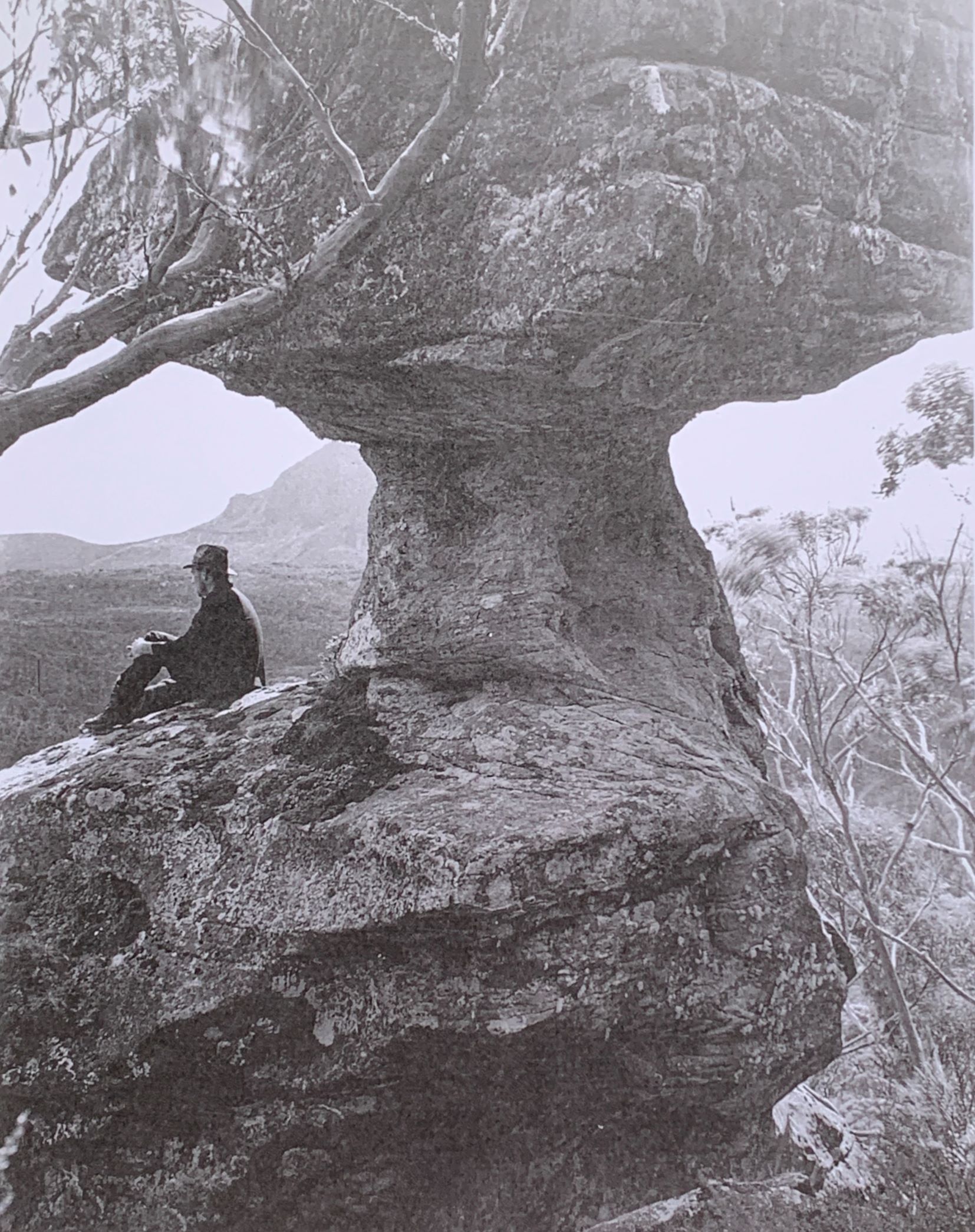
Toad Rock under Mount Pelion East. HJ King photo courtesy of the late Daisy Glennie.
Soon we are gazing on Pelions [sic] giant toad standing on his pedestal on guard, gazing across the tree tops over the hills and far away.[28] We cast wistful glances at Pelion so tantalisingly close, playing hide and seek with the mists; but time and the weather are against us, and we leave him unconquered.
****
One more pleasant picture that day holds — one suggesting Canadian backwoods. A lichen enamelled forest of giant Myrtles [sic] and King Billies, little streamlets making music through tis ferns and mosses — Hidden securely in its heart most picturesque Crusoe huts.[29]
****
Great fire! Billy boiling! Firelight flickering on weary party soon utterly content! Vacuum filled! Thirst quenched! As giants refreshed we rapidly make for home sweet home in the fading light.
****
Our sunshiny day off! A tap awakens us, the door opens, the sunlight streams in! Enter Paddy! Fire alight! Billy boiling! In a trice we are slowly sipping fragrant coffee and nipping biscuits, our eyes feasting on our one picture — a panel of Mount Oakleigh framed in the open doorway. Exit Paddy! Back we lie in luxurious idleness while light-hearted chatter and snatches of song are tossed back and forth through the pine wall.[30]
Leisurely toilet! Leisurely breakfast! Most leisurely household duties! Contented heaping of all culinary responsibilities on capable manly shoulders. Leisurely stroll down to the Forth,[31] very young and pretty between its steep banks. Soon in that secluded spot appears a softly rounded mermaid, splashing joyously in the crystal stream — smiling face and soft brown eyes radiating sheer joy in life. All too soon, alas, she has disappeared, and two commonplace mortals climed [sic] the bank to bask in the sunshine, exchanging low-voiced confidences until a much-uplifted voice summoned them to a wholly unearned, but much appreciated meal.
****
Reluctant farewell to our Pelion Hut, steps retraced with many a backwood [sic] glance! Eyes a fortnight older lingering on remembered scenes. Wolfram! Cautious feet exploring the damp dark mine tunnel![32] Dinner and brief rest at the miners’ huts. On! Over the Forth! Through luxurient foliages! [sic] Through black oozy mud, cautiously skirting the edges of the track at first in the vain endeavour to escape it — then plunging recklessly through it feeling it coldly oozing through the laceholes [sic] of our boots and squelching between our toes!
****
On up the razor back![33] Heats jumping! Breath coming quickly! Loose stones slipping beneath our feet. Ever slower and more slowly in the gathering dark until the pack horses have long disappeared in the gloom above. At long last Paddy and the horses (minus their loads) reappear and the day ends with a mysterious ride in inky darkness. We hear our horses splashing through the water but we cannot see it — we feel branches of trees brushing us as we pass, but these also we cannot see. Perched up on the sky line, we feel like Rebecca on her camel going to meet her lord. All we can see is a black sky far above, pierced by little steel stars. The cool evening air is soft on our faces, and we feel the exquisite luxury of transport on feet other than our own tired ones. Our journey ended, the new hut provokes a smile.[34] The fireplace end is missing and provided easy exit — also access to all and sundry. The floor is thickly strewn from end to end with dry brush etc, but Paddy’s broom of twigs soon sets that to rights. Willing hands have soon unpacked necessaries and gathered our fragrant leafy mattress after a hasty meal on a table which is a most ancient and feeble shell of grey paling which the slightest touch sends askew. An attempt to introduce an extra support shook it so alarmingly that the attempt was abandoned with a fervent prayer that it might outlast our need.
****
Paddy’s voice calling us next morning provoked most dismal groans, but soon we were busily engaged in making preparations for our visit to Cradle of happy memory. Trustfully we leave all but absolute necessities to the mercy of the ‘possum and their friends, and are on the tramp once more.
****
Seated above the wonderful wide sweep of a great cirque, two girls are having shooting lessons, a lovely spray of Blandfordia beside them surveying the performance with wondering eyes.
****
A line of wayfarers pushing rather wearily up seemingly endless slopes thickly clad in a ghostly pale grey thicket of leafless stunted bushes, extraordinarily tough and wiry, its pale skeleton fingers clutching spitefully at our garments as we press through it.
****
A grassy hillside thickly spotted with spikes of pretty pinkish flowers — fly-catchers. Paddy holds a flower in one sunburnt hand — a tiny piece of dry grass in the other. A group of figures kneel round him on the grass, eyes fixed on the flower. Its centre is touched! Down comes the fairy hammer! Little starts! Little exclamations! Peals of laughter! More hammers fall! More starts! More exclamations! More laughter! And so on ad lib.
****
The precious gun and our food are securely hidden in the bushes. Then onward round the white pegs at the base of Cradle, eyes eagerly searching for familiar landmarks. Once round Cradle we allow ourselves one long backward glance at Barn Bluff, softened and beautiful in the deep purple shades of evening, and then on we push. A glad cry announces the first sight of old Waldheim nestling among its pines. We descend the hill a little too far to the left and find ourselves in thick scrub, but on we rush, pushing through clinging branches, jumping, scrambling, anyhow, for we must reach Waldheim before dark actually falls.
Across the plain we break into a quick run — up the hill, round to the kitchen door — the familiar bark of Flock announces us — open comes the door, and we have the hearty surprised greeting of Mine Host.[35] We just have time to note a huge new woodshed facing the kitchen door, when we are swallowed up in the light and warmth. In a very few moments we are round the old table, attending to the needs of the inner man, and making the acquaintance of the other visitors. Then into the cosy old fireplace, chatting and listening to records, old and new, and off to the tent room to long dreamless sleep, buried under piles of grey blankets.
****
Morning! Bright sunshine! Breakfast! Friendly talk! Farewells!
****
On the trail once more! Rest on lovely green fairy mounds starred with tiny daisies. Crater Lake — still — mysterious — deeply, darkly blue — Dove Lake — sparkling dancing in the glorious sunlight. As we climb, many a backward glance is cast at Waldheim nestling in its valley and farewell cooees reach us, softly floating across the distance. The last thing we see as we disappear over the top of Cradle is a friendly white signal waving, and then we set to work in earnest to reach our hidden food.
But the day is far spent when at length it is reached and a silent and empty party sit down to the long deferred meal. But very soon our good friend ‘Billy’ works his magic beneficently as ever, and we laugh once more.
We are seated on the ridge between Cradle and Barn Bluff— those stately old giants gazing serenely over our heads in the soft evening light. One whose face is crimson with sunburn, produces a battered tube of lanoline wrapped in worn brown paper having a goodly share of lanoline upon it. With this paper he proceeds to anoint his burning face. A girl, equally crimson of visage, rummaging among a tiny stock of treasures produces a jar of face cream. Apparently the jolting of the trip has caused the cream to spread itself outside the jar. With this she economically proceeds to anoint her face. Something strange about it invites hasty investigation and with utmost horror she finds she has carefully rubbed tooth-paste [sic] upon her cherished countenance. And those hoary old giants suffer not a wrinkle in their old faces to twitch during the unseemly and ridiculous mirth that follows.
****
Rapidly we push on, but all too soon black darkness is upon us. Closely, blindly we follow in Paddy’s footsteps slipping, stumbling, over bogs, tussocks, stones, seeing not an inch in front of us except where the gleam of water shines warningly. At length rest becoming imperative, we stretch wearing limbs on the cool earth, gazing into the starlit immensity above. Voices break the silence ‘Can you see the duck?’ — minute directions — mystified eyes vainly straining. ‘See the handle of the saucepan — now the sweep of its breast!’ Triumphant laughter! ‘Acres of duck!’ ‘A bonza duck.’ ‘Pooh! It’s a brimming old duck!’ Then mightily refreshed by the sight of that duck we resume our stumbling march! The top of the hill is reached and soon home sweet home with the fresh night blowing through it.
****
Refreshment! Our leafy couches — and Silence.
****
Breakfast in bed and one more lazy sunshiny day of roaming round our hut and the next day we depart! The pack horses have disappeared — absolute necessities are packed and the bulk of the luggage left behind for those most foolish horses on their return up the razor back. This time we have leisure and light to see the beauties bordering the steep track and at the hill’s foot come upon our truant horses returning in charge of the packman. Most gladly the packs are shed and left in the pathway to be picked up.
Through sun-flecked paths the giant bracken bending low and caressing us as we pass we reach the beautiful Forth once more and hot and tired we clamber down its bridge supports to lunch on the cool flat stones in the shade of giant leatherwoods, one mass of beautiful bloom. Here the river is broad and deep and we sit in luxurious coolness watching its smooth flow until the word to march on.
****
Our first hut once more — We now recognise it as a palace with its real glass window and movable table and bunks — wallaby patties made by Paddy — then a visit to our friendly old lady, this time in most wretched and squalid sickness. A nightdress of indescribable hue hangs on her thin form and she is covered by a few soiled and tattered rags; no single sweet or fresh thing to be seen — lack of every little refinement to lighten sickness. On the walls are the only things that might attract attention — every inch of them is covered with magazine cuttings and girls, dogs, horses, all manner of things stare at the poor frail old form. When we left the listless eyes were a little brighter, and in our hearts was a deep pity for all lonely bush women, and especially all sick ones.
****
By dinner time next day our driver and a visiting surveyor had joined us, and we all sat down to our last bush meal — bully beef and onions — with borrowed cutlery added to our already motley collection.
****
One evening the moon looked down and saw the dear little fluffy nurse and the new Doctor [sic] climbing the steps to the ‘Eagles Eyrie’. Now, those steps are steep and the little nurse is plump, so is it any wonder that presently they sat down upon a step instead of climbing it?
When the little nurse got back her breath the moon heard in regretful tones, ‘Our pretty patient leaves to-morrow’. ‘What in the world did you do to her to-day? She looked as if she had got hold of the Elixir of Life.’ [sic] ‘I guess she had’ said the girl softly, ‘And he must have had a dose himself too, judging by the look on his face when he left.’ ‘Well! He’s a lucky chap!’ said the man heartily, ‘Who is he?’ ‘P Lane was on his bag.’ ‘Jerusalem! It must be old Percy! Used to know him at school. His dad lost a lot of money in that Barn Bluff oil show. Met him to-day, and he told me he had struck it lucky — in more ways than one it seems, but he didn’t mention that.’
[1] That is, the old two-chimney Mount Pelion Mines hut that stood below Old Pelion Hut and fell down in 1948.
[2] ET Emmett, ‘Scenic reserve: memorable week’s tour: Cradle Mountain to Lake St Clair: Hobart party’s experience’, Mercury, 10 January 1931, p.2.
[3] See ‘A dip into the Waldheim mailbag’.
[4] NS573/1/1/11 (Tasmanian Archives, afterwards TA).
[5] Years are from headstone, Carr Villa Memorial Park, Launceston; plus 1901 British Census as below.
[6] British Census, 1901, Administrative County of London, Civil Parish of Heathorn, p.22 (accessed through Ancestry.com.au).
[7] Electoral roll, Division of Bass, Subdivision of West Launceston, 1922, p.48. See also will of Henry Sidney Scott, in which he made his daughter Vera May Scott his sole executrix and beneficiary, will no.18727, AD960/1/56 (TA).
[8] ‘Thanks’, Examiner, 23 October 1945, p.2.
[9] See will no.43508, AD960/1/94 (TA).
[10] Years are from headstone, Carr Villa Memorial Park, Launceston.
[11] Passenger list for the Orana, October 1891, Series BT27, British National Archives (accessed through Ancestry.com.au).
[12] Electoral roll, Division of Bass, Subdivision of Launceston Central, 1922, p.34.
[13] Electoral roll, Division of Bass, Subdivision of Launceston Central, 1968, p.16.
[14] Descriptive list of immigrants, ss Coptic, arriving in Hobart 27 July 1888,. CB7/12/1/12–13, p.40 (TA), https://librariestas.ent.sirsidynix.net.au/client/en_AU/names/search/results?s=harriet+cumings&searchTarget=library&qu=harriet&qu=cumings, accessed 10 June 2023.
[15] ‘Current topics’, Launceston Examiner, 13 May 1893, p.5.
[16] See, for example, ‘Education’, Launceston Examiner, 4 January 1893, p.2; ‘Educational’, Daily Telegraph, 21 January 1896, p.4; ‘Diamond jubilee’, Launceston Examiner, 15 June 1897, p.6.
[17] Married 21 January 1903, registration no.608/1903, at St Paul’s Church, Launceston (TA).
[18] John Gregson’s headstone details are recorded on the Lorinna Cemetery page, Kentish Museum Trust, All known burials in the Kentish Municipality, 2nd edn., 2007. Elizabeth Gregson’s patient admission record for the New Town Charitable Infirmary on 5 August 1926 is HSD274/1/1 (TA), https://librariestas.ent.sirsidynix.net.au/client/en_AU/tas/search/detailnonmodal/ent:$002f$002fARCHIVES_DIGITISED$002f0$002fARCHIVES_DIG_DIX:HSD274-1-1/one?qu=%22hsd274%2F1%2F1%22, accessed 13 October 2019. Her age was given as 73 years. She never left this institution. Her date of death is also recorded there on 11 June 1927, death record no.1656/1927 (Tasmanian Pioneers Index).
[19] In the Weindorfer diaries the only instance of a party arriving at Waldheim from Commonwealth Creek/Lake McRae is Fred and Ida Smithies on 18 April 1927. They went around the eastern side of Cradle via Lake Rodway, but returned to Commonwealth Creek/Lake McRae via the western side of Cradle on 20 April 1927.
[20] Gustav Weindorfer diary, April 1922, NS234/27/1/8 (TA).
[21] The new woodshed was completed 7 August 1923, the tent room was finished 2 December 1924, Gustav Weindorfer diary (Queen Victoria Museum and Art Gallery, afterwards QVMAG).
[22] Gustav Weindorfer diary (QVMAG).
[23] Gustav Weindorfer diary 9 May 1923 and 13 October 1926 (QVMAG).
[24] The author describes travelling south on Patons Road towards the Wolfram Mine on the upper Forth River. The two huts were Gisborne’s Hut, owned by Hobart schoolteacher, orchardist, journalist and political commentator Frederic (FAW) Gisborne, and a hut nearby which was built by Mount Pelion Mines. The Gregsons appear to have occupied the former until the mining hut became available in 1921.
[25] The woman described is Elizabeth Gregson. For the full story of John and Elizabeth Gregson, see Simon Cubit and Nic Haygarth, Historic Tasmanian mountain huts: through the photographer’s lens, Forty South Publishing, Hobart, 2015, pp.100–105.
[26] The author describes the Zigzag Track, the pack track between the Wolfram Mine and the Pelion huts.
[27] ‘Jays’ or ‘black jays’ are currawongs.
[28] Toad Rock, under Mount Pelion East.
[29] A reference to the Crusoe Hut in Cataract Gorge, Launceston, a rustic hut established on the main walkway in 1893 as a reference to Daniel Defoe’s 1719 novel Robinson Crusoe, about a castaway marooned on an island off the coast of Venezuela.
[30] The larger hut at Pelion Plain, the two-chimney workers’ hut, was built of eucalypt. ‘Pine wall’ confirms that the hut the author slept in was the mine manager’s hut, now known as Old Pelion Hut.
[31] That is, Douglas Creek.
[32] The main adit of the Wolfram Mine, aka the Mount Oakleigh Wolfram Mine. Wolfram (tungsten) had been needed for munitions during World War One but after the war ended the price of tungsten dropped and the mine was abandoned.
[33] The notoriously steep Razorback Track between the Forth River and the Barn Bluff Copper Mine.
[34] Probably one of the huts at the abandoned Barn Bluff Copper Mine at Commonwealth Creek.
[35] Gustav Weindorfer, proprietor of Waldheim Chalet 1912–32.
by Nic Haygarth | 17/06/23 | Tasmanian high country history, Tasmanian nature tourism history
Tired of Kindling Kindred? [1] Well, here’s the original Cradle Mountain gushfest. The papers of Launceston mountaineer Fred Smithies contain a fictional account of a visit to Gustav Weindorfer’s Cradle Valley tourist resort Waldheim a century ago.[2] The author of ‘A dip into the Waldheim mailbag’ used fictional letters written home from Waldheim by the visitors to describe the events of the fictional trip. The imaginary party consisted of John and Grace Moore, their daughter Mona Moore, their niece Claudia Crane—and a visiting boy named Percy Lane. The author, who had obviously stayed at Waldheim, gushed high-spirited prose to the rhythms of Bob Quaile’s wagonette ride from Wilmot to Waldheim via Daisy Dell, and continued the girlish banter with Weindorfer.
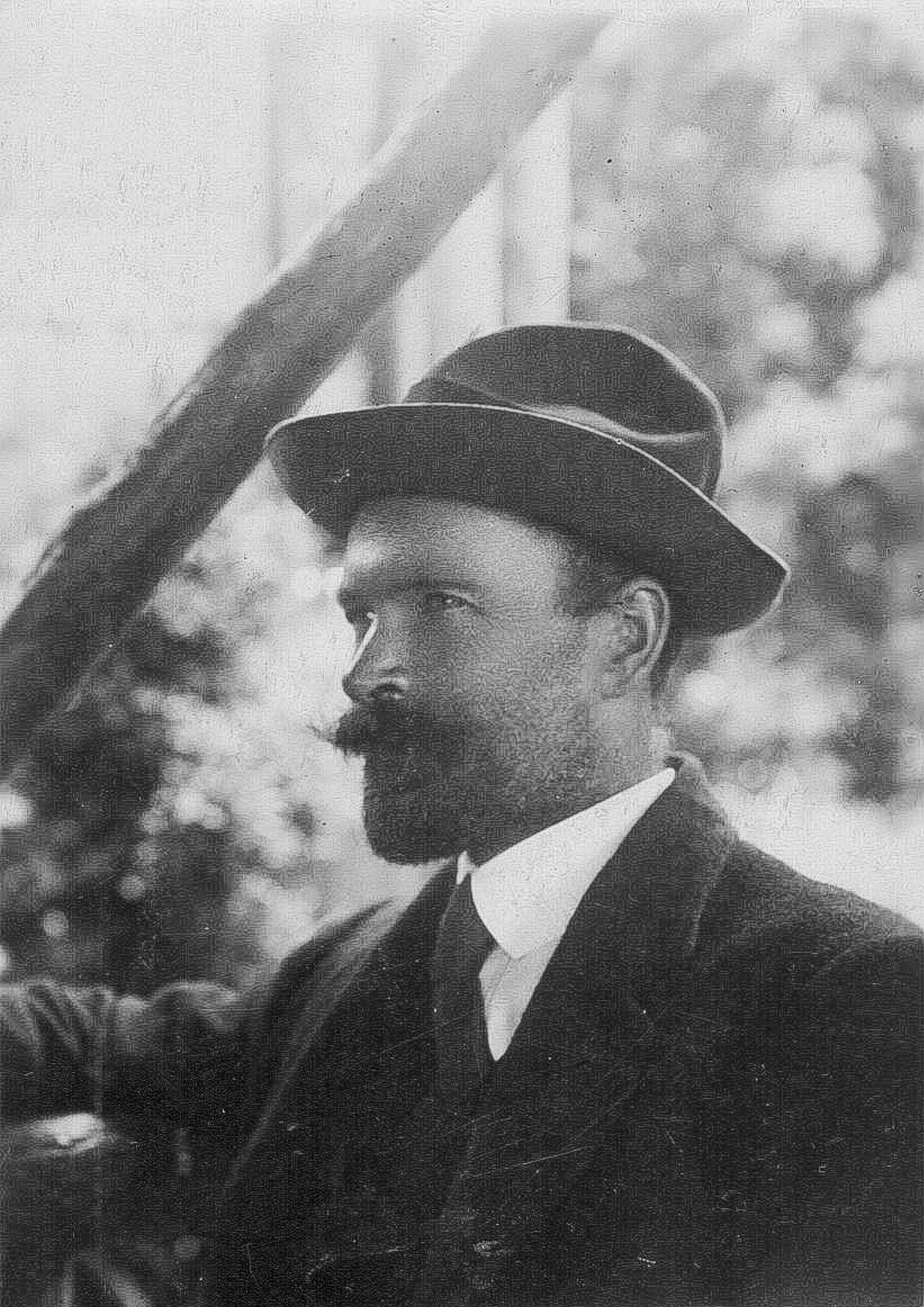
Gustav Weindorfer. Ron Smith photo.
Who was this accomplished author? Many women lost it over the cultured Carinthian immigrant ensconced in his mountain eyrie. In 1923, for example, Weindorfer was snowed in with the scary South African Maude Van der Riet, who later penned an epistle called ‘The Cradle Mountain: a climb to the peak: the world’s view’. The 49-year-old nurse and writer described Weindorfer as
tall and thin like a young cedar tree, with a moustache turned skywards the color [sic] Titian raved about in all his pictures. Mountain air complexion; eyes, what eyes! They flashed like fork lightning on pointed swords …[3]
However, it is likely that the mailbag author visited Waldheim earlier, in 1922. The clue is the name Percy Lane, which appears to be an amalgam of two surnames of real people with a Waldheim connection: men called Percy and Lane were working at the Tasman Oil Company’s Barn Bluff shale oil mine. In his diaries Weindorfer recorded Percy and Lane arriving at Waldheim from Barn Bluff on 21 March 1922 and returning to the oil show next day. A Launceston party by the name of Joscelyne was staying at Waldheim at that time, and their day-by-day activities mostly match those described in ‘A dip into the Waldheim mailbag’: arriving on Quaile’s wagonette, then visiting Hounslow Heath, Dove Lake/Mount Campbell and the Cradle Mountain summit.
The names of the Joscelyne party members are recorded in the Waldheim Visitors Book. A poem by Vera M Scott appears as an entry for the period 14–25 March 1922:
A party of five to Cradle Mount came
To visit ‘mine host’, Weindorfer by name
So charming they found him
As they clustered around him
That they marvelled no more at his fame.
They soon settled down to his motto & creed
That ‘nothing else matters’ and ‘of time there’s no need’.
They devoured his puddings with spring water mixed
But after two helpings they found themselves fixed,
And with coffee to follow they had a good feed.
One fine morning they thought up the Cradle they’d climb
Having nothing to do, and plenty of time
So they all started out
With mine host for a scout
The dogs, meanwhile, barking a chime.
The old Cradle frowned down on this frivolous crowd
And said ‘I know well how to deal with the proud.
I’ll teach them to cheek me,
And with lightness to treat me,
I’ll send them home all humbly bowed’.
So they started to climb, arrived at the top,
And the Cradle smiled softly, and said ‘I’ll soon stop
These impertinent mortals
From storming my portals’.
Sure enough they reached ‘Waldheim’ just ready to drop.
Now this party of five had vocations in town
And so, most reluctantly, had to come down
From that land near to Heaven
Of which fun is the leaven
And ‘Waldheim’ itself is the crown.
The visitors book entry bears four other signatures: Lydia Morrison, J [Julius] Norman Piper, HS [Horace Samuel] Joscelyne and his wife HM [Harriet Mary, known as ‘Addie’] Joscelyne née Cumings.[4] All these people were middle-aged but, as Maude Van der Riet had shown, when it came to Weindorfer age did not preclude gushing. Horace Joscelyne was a Trevallyn grocer’s assistant, while Addie managed their house at 26 Delamere Crescent, Trevallyn, Launceston.[5] They had no children. Piper was a soon-to-be-married jeweller in Bourke Street, Launceston.[6] Scott, the visitors book poet, Morrison and Addie Joscelyne seem the most likely candidates for authorship of ‘A dip into the Waldheim mailbag’. It is unknown whether any of them practised as a romance writer, but one of them certainly had the skills to do so.
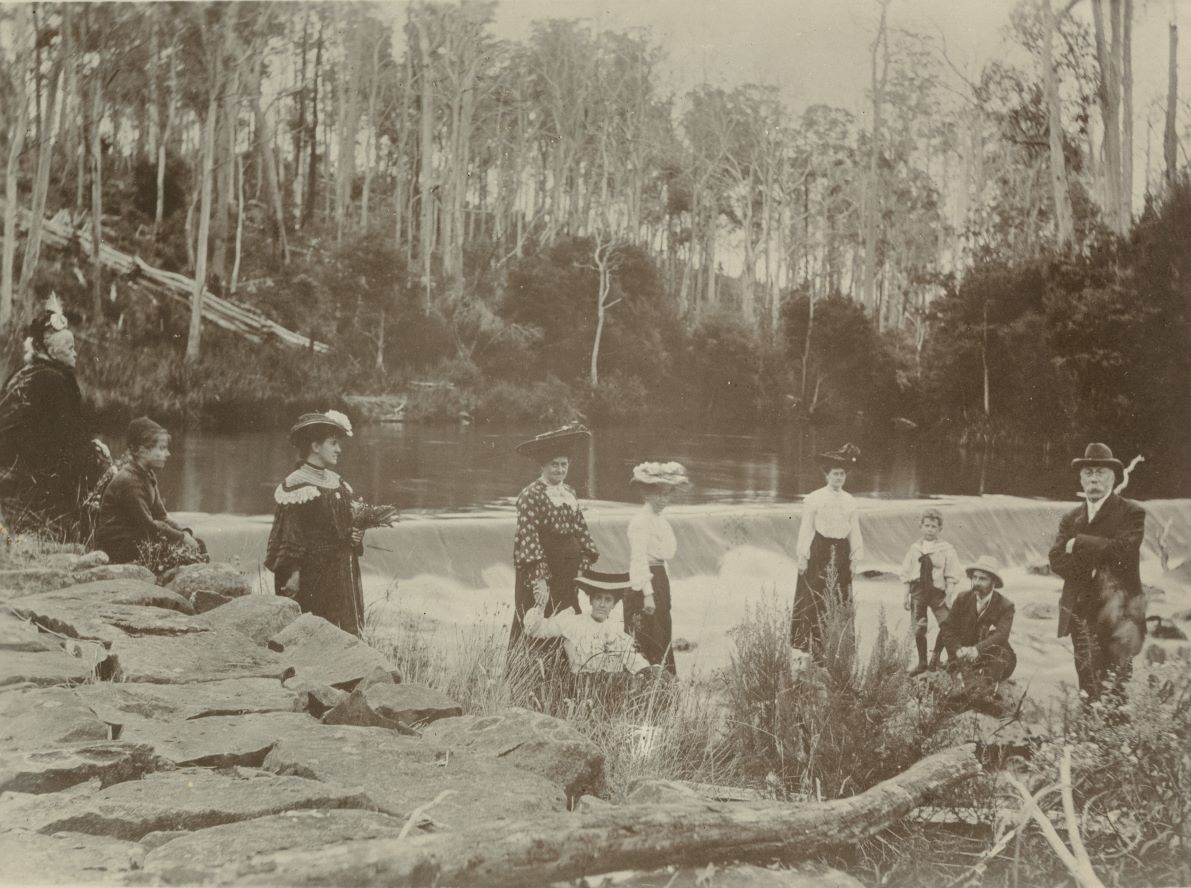
A picnic photo of Scotts and Cumings: (left to right) Caroline Cumings, AC Jowett, May Scott, Minnie Jowett née Cumings, Addie Joscelyne née Cumings, L Jowett, Wilfred Jowett, HWH Jowett and Henry Sidney Scott. Was Vera May Scott the photographer? LMSS754/1/28 (TA).
Vera May Scott (1886–1962)[7] was born at Battersea, London. At the 1901 British census she was a 15-year-old living in London with her 47-year-old piano tuner father Henry Sidney Scott and 37-year-old Brisbane-born mother May Scott.[8] No record of the family’s migration was found, but in 1922 Vera May Scott was an unmarried typist living at 28 Delamere Crescent, Trevallyn with her parents and sister Eleanor Scott.[9] Scott lived next door to the Joscelynes and had a strong connection to the family. In 1945 she thanked Horace Joscelyne for ‘unfailing kindness’ during her mother’s long illness.[10] Rupert William Joscelyne Hart, whom Scott recognised in her will, was the son of Horace Joscelyne’s sister Violet Mary Joscelyne.[11]
Lydia Morrison (1886–1971)[12] appears to have emigrated from England as a small child in 1891, along with her two-year-old brother and her parents, 28-year-old Lydia Morrison senior and 35-year-old farmer William Morrison.[13] In 1922 Lydia lived with her parents, her sister Dorothy Mary Morrison and brother William Morrison junior, at 211 St John Street, Launceston.[14] Forty-six years later in 1968 Lydia was still listed as an unmarried clerk—at 82 years of age—and living with her bookbinder sister at 6 Union Street, Launceston.[15]
Harriet (‘Addie’) Joscelyne née Cumings (c1872–1946) emigrated from England with her sister as a teenaged nursemaid in 1888. Her parents, Ebenezer and Caroline Cumings, had preceded her and were already Launceston residents.[16] Addie’s older sister Minnie gave her occupation in the passenger list as schoolteacher, and until her marriage in 1893 she operated the Trevallyn Preparatory School.[17] At this point Addie Cumings took over from her, continuing the school until at least 1897.[18] This suggests that she was at least reasonably well educated. Addie Cumings married Horace Samuel Joscelyne at Launceston in 1903.[19]
Tasmania’s great romance novelist of the time, Marie Bjelke Petersen, threatened to pen a Cradle Mountain tearjerker which never eventuated.[20] Given her habitual bible bashing, some may see that as a good thing, but a Bjelke Petersen blockbuster might have done wonders for Weindorfer’s business. It would be surprising if Bjelke Petersen hadn’t pencilled him in as a model for her male lead—like Robert Sticht in her Mount Lyell Mine saga Dusk (1921)—and Waldheim as her anonymous location. Like driver Vic Whyman in her Jewelled Nights (1923), Cradle Mountain coach driver Bob Quaile would surely have appeared under an alias in her new screed. Bjelke Petersen championed Tasmania’s great forests and mountain scenery, and as such may have looked askance at the ‘grass tree’ (Richea pandanifolia) bonfire in ‘A dip into the Waldheim mailbag’.
However, much of the latter text is straight out of the BP playbook. The unknown author’s heroine Claudia Crane even notes ‘I could not help thinking what rich material a novelist might find here’, before listing elements of the region’s romantic history. ‘Why go to other lands for the setting for tales of adventure, of love, and mystery?’ Why indeed? Cradle Mountain was a romance writer’s paradise waiting to be reimagined.
A DIP INTO THE WALDHEIM MAILBAG
From Claudia Crane to an invalid friend.
Wilmot
My dear Margaret,
I am on the eve of adventures strange and wonderful — bound for a lonely chalet in a mountain valley, 2000 feet above the sea level. How does that appeal to your romantic soul, oh! my friend? And, moreover, the said chalet is inhabited by a solitary man, who is cook, housemaid, washerwoman, waiter and guide rolled into one. Poor Aunt Grace is filled with the most dismal forebodings as to the dinners and beds we shall get, but to Mona (who has just turned sixteen) and myself, the prospect is most alluring — the uncertainty — the romance — of it all makes an irresistible appeal. (All the same we hope the dinners are good.)
On arriving we had a hearty welcome from Mr Quaile, a fine white haired, weather beaten old chap with a face like a rosy apple.[21] Mona christened him ‘Daddy’ on the spot and my heart warmed to him straight away as I caught the kindly, compassionate glance that just rested on my crooked shoulders. He led us on the verandah of a funny rather rambling little house and introduced us to the quaint, bright little hostess. When we trooped inside we found the place surprisingly roomy and comfy and we all approved of the cheery fire burning merrily in the open fireplace and straightaway fell in love with the inviting little white beds waiting for us. Now my inner woman having been well satisfied, I am writing this epistle in front of that same fire, with the lovliest [sic] pink lilies smiling down at me from the high mantel.
The little township seems to be a paradise for lilies. This afternoon as we were sitting on the grass in front of the house a lovely slip of a girl passed with a most beautiful cluster of the Golden Lily of Japan nestling in her arms peeping into her sweet oval face. I wonder who she is? She looked nearly as lovely as her lilies. We were favoured with many a kindly curious glance from the passers by [sic] and Mona was highly amused when one passing man called to us ‘You will find it cold up the mountains’.
Ah well that small white bed is calling me, so Good-night.
Yours,
Claudia (in search of adventure)
PS I find that the lovely girl is Daddy Q’s daughter.[22]
C.
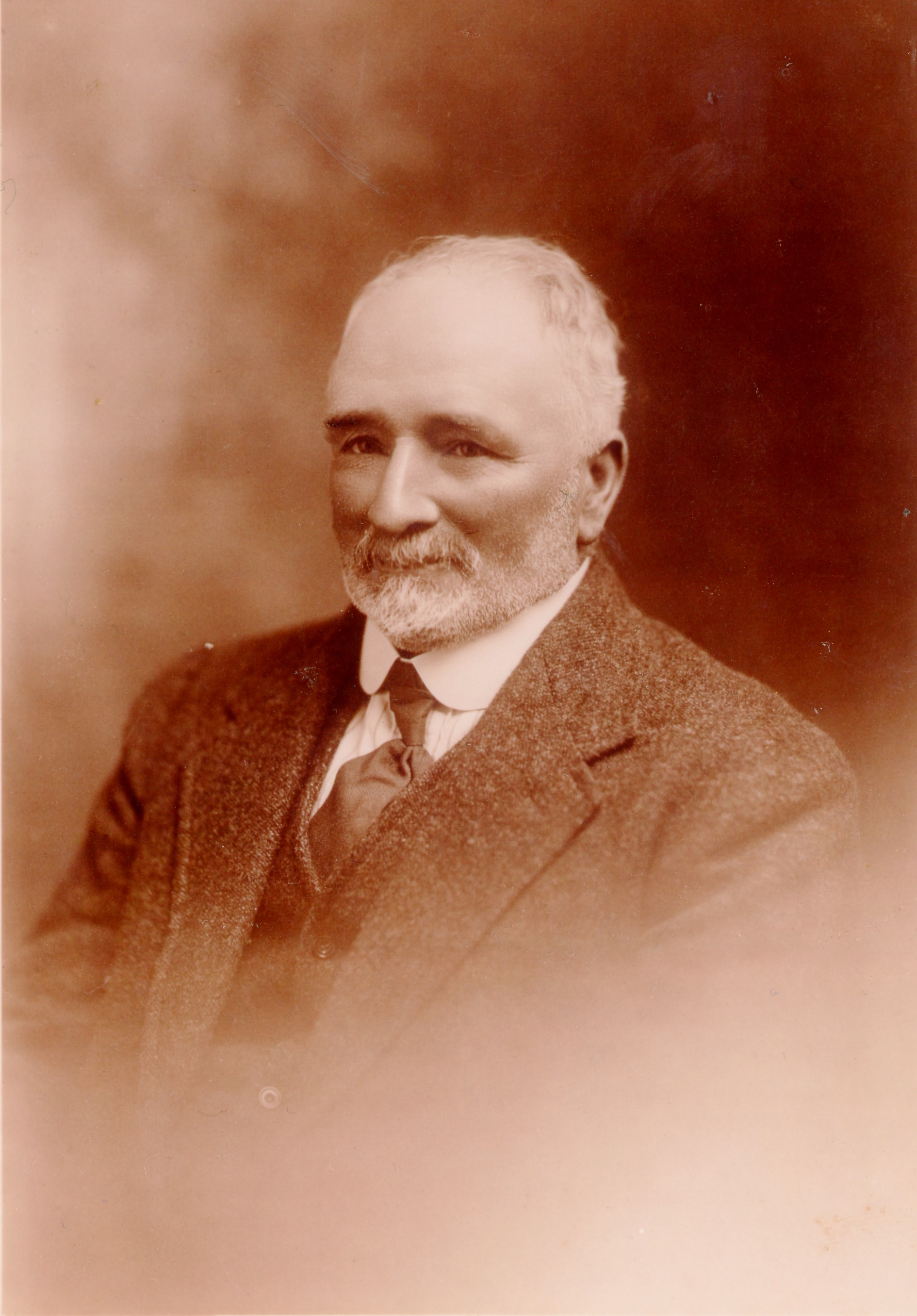
Bob Quaile. Photo courtesy of Leslie Quaile.
From Claudia to Margaret.
Dear Margaret,
We left the world behind at seven o’clock this morning, in the most glorious sunshine. Our vehicle was a weather beaten old warrior, and had evidently started life as a mailcoach [sic]. We were inclined to smile at it and our smiles broadened as our driver with a twinkle in his eyes, implored us to be careful of the upholstering, but before our journey ended we had a huge respect for our coach. We set off merrily along a very fine road, of which Daddy Q was very proud. He is evidently a man of many parts and equally at home as councillor, farmer, miner, road-maker, and moreover is no mean conversationalist.[23] He proved quite equal to carrying on several conversations at once, interspersed with various remarks to horses (sometimes with funny results, as for instance when the remark ‘Gee up, Commonwealth Bank’ nearly sent Mona into hysterics.) I had always had a vague idea that drivers of horses used fairly lurid language but, ‘Gee up! You lazy rubbish’! was about the most violent expression we heard — much to Mona’s disappointment. For the 1st time in my life, I found myself passing through mining country. We passed quite close to the ‘Shepherd and Murphy’, and Round Hill mines. Daddy Q also has a claim which he pointed out to us.[24] Further along the road we had quite a picturesque glimpse of a fine herd of wild cattle, grazing on a hillside. Great tracts of the country we passed through had been burnt, and I saw a variety of fence that was new to me —composed of simply of single huge trunks (mostly chared [sic]) laid end to end.
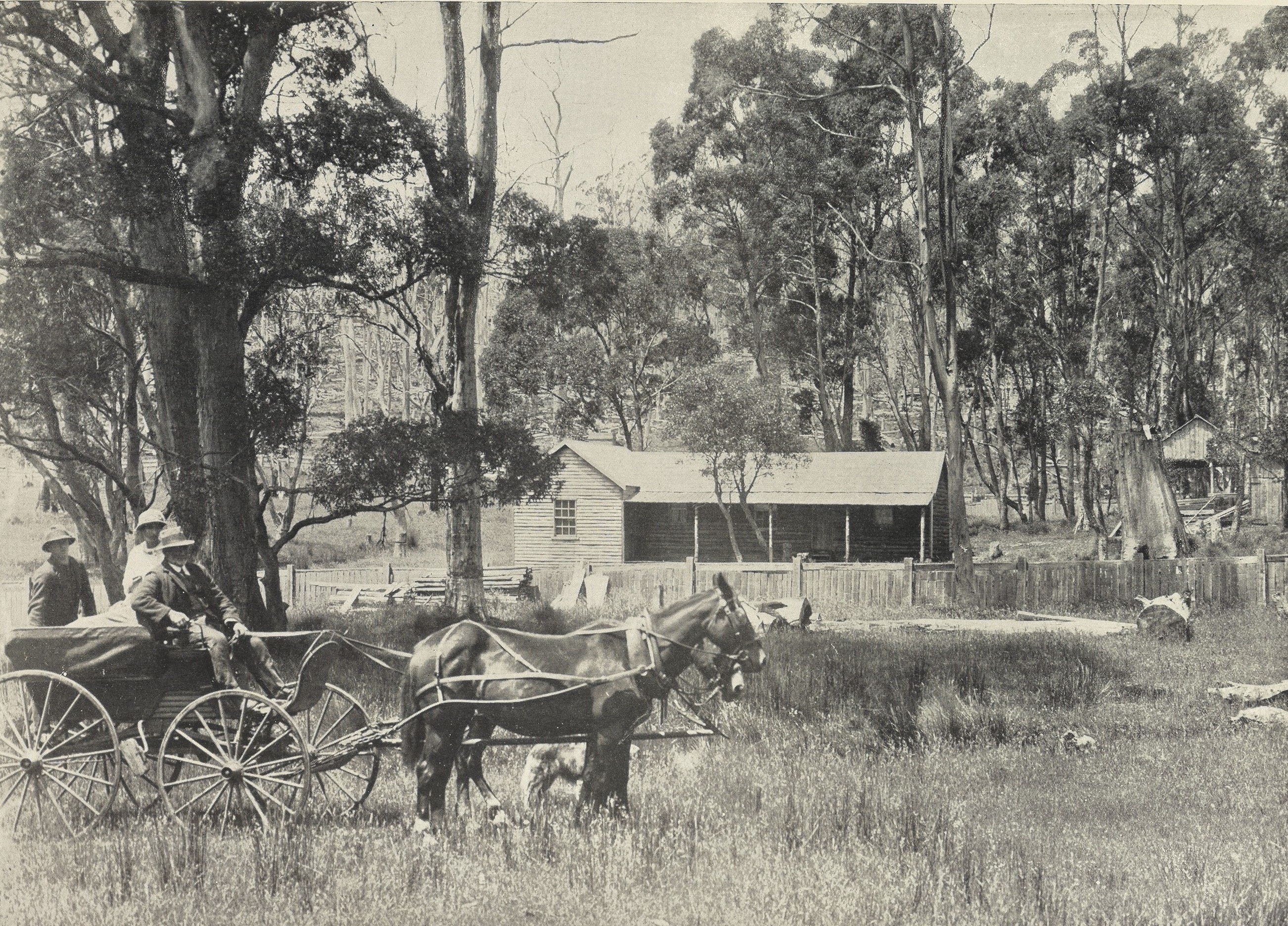
A posed photo of Bob Quaile with two tourists in his wagonette at Daisy Dell. Burrows photo from the Weekly Courier, 15 February 1923, p.21.
I liked the black and white effect. The quick eye of our driver distinguished some of his own cattle among others, and soon the truants were trotting along in front of us. By this time our fine road was left behind and we were passing along what we were assured was a ‘made road’, and nothing to what was in front of us.
We who were facing each other were bobbing and bowing to each other in a most absurd way. But it was a new experience to us and we rather enjoyed it, but nevertheless no-one grumbled when the horses were allowed to leave the ‘made road’ and take their way through paddocks to ‘Daisy Dell’, where quite our ideal dairy maid — fresh, comely and plump — served us with butter, cheese and cakes of the best. The horses were glad of the spell, as the road had been steadily ascending the whole way, and it was a pretty strenuous climb for them. We started once more, this time in a fine drizzling rain, which prevented our getting any of the early glimpses of the Cradle to which we had been looking forward.
Soon after we had passed Pencil Pine Creek and the Sawmill we came across a gang of men hard at work on the road, and there a halt was called, and our luggage had to be ‘packed’.[25] The girls decided to stroll on in the soft rain, and when the horses caught us up we could not help smiling at the poor pack horse — he looked for all the world like a camel with a huge hump. The decree went forth that we were to ride, to Mona’s huge delight and my inward dismay. But once mounted, I found it delightful to gaze round without troubling what my feet were doing.
The last three miles of our way lay along a lovely little green valley, much of it by the side of the Dove River. The 1st glimpses of our new home came rather unexpectedly, but a very pretty glimpse it was in spite of the rain. Soon we were at the porch and found ourselves welcomed, not by an old man, as we were expecting, but by a big dark-bearded man, in the prime of life.
We were soon lifted from the saddle and walked into the house on rather wobbly legs, to be greeted by a huge fire and a deep barking proceeding from under the couch. The barker proved to be ‘Flock’, a dignified and matronly old dog, who soon came out and made friends with us, together with her son, ‘Flick’ who is, according to his owner, ‘young and silly and spoiled by the ladies’. Our bedroom opens out of the living room and contains 4 bunks. Moss and lichen still clings to the small trees used as posts in the room, also to those supporting the bunks above our heads. The picture frames are of bark trimmed with lichen. The tassel on our blind is a dear little fir cone. The recess for our washstand (which I grieve to say looks uncommonly like a packing case, curtained,) is lighting by a tiny fascinating window made of three old negatives. The seats are merely lengths of tree trunk stood on end. The walls, of King Billy pine, are fine, each plank having a broad white streak running through it where the sap once ran. The rugs on our floor are badger skins, but the star room boasts a real carpet and a leopard skin, head and all.
I am too tired to write more to-night.
Yours,
Claudia.
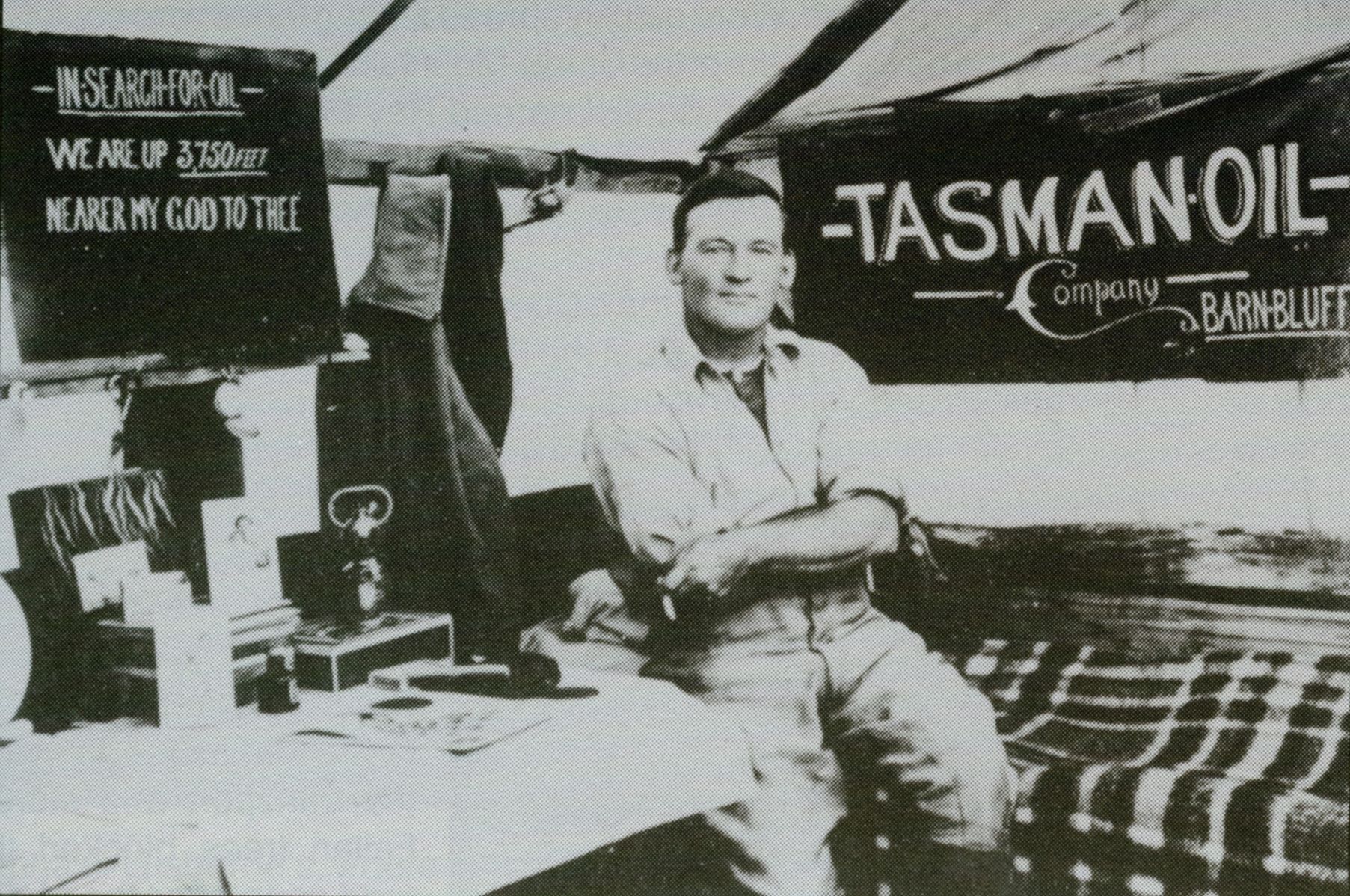
‘Nearer my God to thee’: AG Black, mine manager for the Tasman Oil Company at Barn Bluff, Christmas 1921, with his gun and family photos. Courtesy of the late Es Connell.
Mona to her girl friend [sic].
My Darling Marie,
Such a lovely thing has happened. A perfectly beautiful boy came here yesterday. He has most glorious brown eyes and a lovely big nose like Napoleon. His father and Dad used to be mates. His father is one of the directors in some mine here, and he worried his father till he let him come here to work, but now he is sick of it, and so Mum has asked him to come to town and stay for a holiday and it is such fun having him here, everyone else is pretty old except Claudia, she is a love, but she can’t tear round like I want to.[26] Percy had such a lark this morning. You know Mr W always brings us a cup of coffee before we get up. Well he knocked at the door and said ‘milk for the babies’ like he always does and I got on my elbow ready to take my cup (Claudia always get the tray — a bonza one made out of KB pine). When I looked up there was Percy grinning like a Cheshire cat and he had on the most beautiful silk pyjamas with purple stripes and a silk cord round the waist (Dad says he must be an awful fop to wear silk and he looked beautiful in them). I gave a most awful yell and nearly dropped the cup on the floor and Percy and I just squealed, it was so funny. We made such a row that everyone came trooping in to see the fun until Mum rapped on the wall and they all got for their lives.
Oh! I say Marie, did you know I had pretty ankles? Mr W served out leggings and putties to Mum and Claudia, but he wouldn’t give me any, because he said my ankles were the nicest he had seen for a long time and it was a pity to hide them. I thought perhaps he was stuffing, but he wasn’t because I asked Claudia, and she said it was quite true, she had often admired them. So that’s my first live compliment.
Mum is getting to be quite a sport up here — she doesn’t chip a bit. Every morning she goes out to the Kitchen for the Porridge jazz with the rest of us. We all streak out into the Kitchen like a lot of Oliver Twists and everyone grabs their own Porridge when Mr W puts it out and there is a procession back into the Dining-Room. But no-one ever asks for more, cos he gives us such big platefuls.
I do hate washing porridge pots at home, don’t you? But it is quite easy here the pot just gets stuck out on the roof until next morning and the Porridge comes off without any trouble. And he’s got quite a cute idea for washing windows, he just takes them right out and puts them in the Creek, and both sides are washed at once.
Mum doesn’t even mind getting her feet wet. You know coming out she wouldn’t even let me get out of the Trap to see the Pencil Pine Fall cos it was raining, and I might get my feet wet. But up here they are nearly always wet, and Mum thinks nothing of one foot slipping into a hole with water a foot deep in it. All the wet boots and stockings look so funny dangling round the fire place at night.
That Percy is pulling my hair so I’ll have to go and hammer him now so Ta-Ta, heaps of love.
Mona.
PS I hope you get that little note I sent by pigeon post. It was fun letting him go.
Mr John Moore to Percy’s father.
Dear Lane,
Suppose you will be somewhat surprised to note the address heading this letter — nearly as surprised as I was when your son rode in here. The lad had been sent over from the mine on an errand and was overjoyed to find our party. Truth to tell I think he is beginning to find the mine life a trifle monotonous and a short spell would [do] him no harm. Unless we hear from you to the contrary, therefore, it would give us great pleasure to keep him with us during our stay here and to take him home for a few weeks change. We would be glad if you would drop the manager a line and make this right for him. He and my little girl Mona have become great pals and are keeping all the old fogies alive with their harmless nonsense.
You should really take a spell and run over and see this place next summer. By that time the road will be right through and the accommodation even better than now, as our host has great plans for enlarging and improving the house and will probably have domestic help also.
At the present time he does the whole of the housework and cooking unaided, in addition to this work as guide, but expects the business will become far too large for that to continue possible [sic]. The wife was really rather worried about domestic arrangements, but our host soon proved he understood the important art of cooking a good dinner. On our first day we sat down to roast mutton, potatoes boiled in their skins and an excellent boiled ‘spring water’ pudding the flavouring of which aroused much curiosity among the ladies. As a matter of fact I found that ½ cup of rum was used and we have since had a similar concoction known as Barn Bluff pudding flavoured with port wine. Tip top coffee is the finishing touch to our meals. You will see that we are in no danger of starvation.
The house is unique, built almost entirely by our host. A picturesque porch opens into the dining room, 3 bed-rooms, the kitchen and wood shed open out of that, and one other bedroom out of the kitchen. There is an arrangement of curtains which can be drawn at will round the central part of the dining room to exclude draughts. Two long seats after the style of box couches run each side of the table and at the foot is an extremely solid arm chair cut from a tree trunk. The fire place is one of those huge affairs within which one can sit and is always garnished with a hug back log under which mine host can scarcely stagger. The kitchen is compact enough to be found on board ship and the owner can stand in the middle and reach almost anything he wants. By the way, we men, clad comfortably in pyjamas and slippers start most days in the kitchen with a good old yarn and smoke before the ladies are astir. You would enjoy those yarns. Most of the bedrooms are fitted with bunks, that occupied by my wife and self being the only one with ordinary beds. Our room also boasts a pretty little private balcony which the ladies have christened ‘The Juliet balcony.’ The tent room and the huts are some yards from the main buildings and are furnished with a couple of beds and a fire place with wood-shed attached, the hut having in addition a loft with an extra bed designed to accommodate mine host in times of pressure. The feature of the place however, is the bath room, a hut with its own small verandah standing on the brink of a creek a few yards from the house. Water is supplied from the creek by a most ingenious arrangement and may be heated in the copper which always stands on the huge fire place.
One thing I know will strongly attract you, there is a fine gramophone here, and a first class selection of records and we have enjoyed many a good concert as we sat round the fire after a long day’s tramp.
I should certainly like to come again next summer and possibly you can arrange to join our party then. However, we can discuss that at our next meeting.
Yours faithfully,
J Moore.
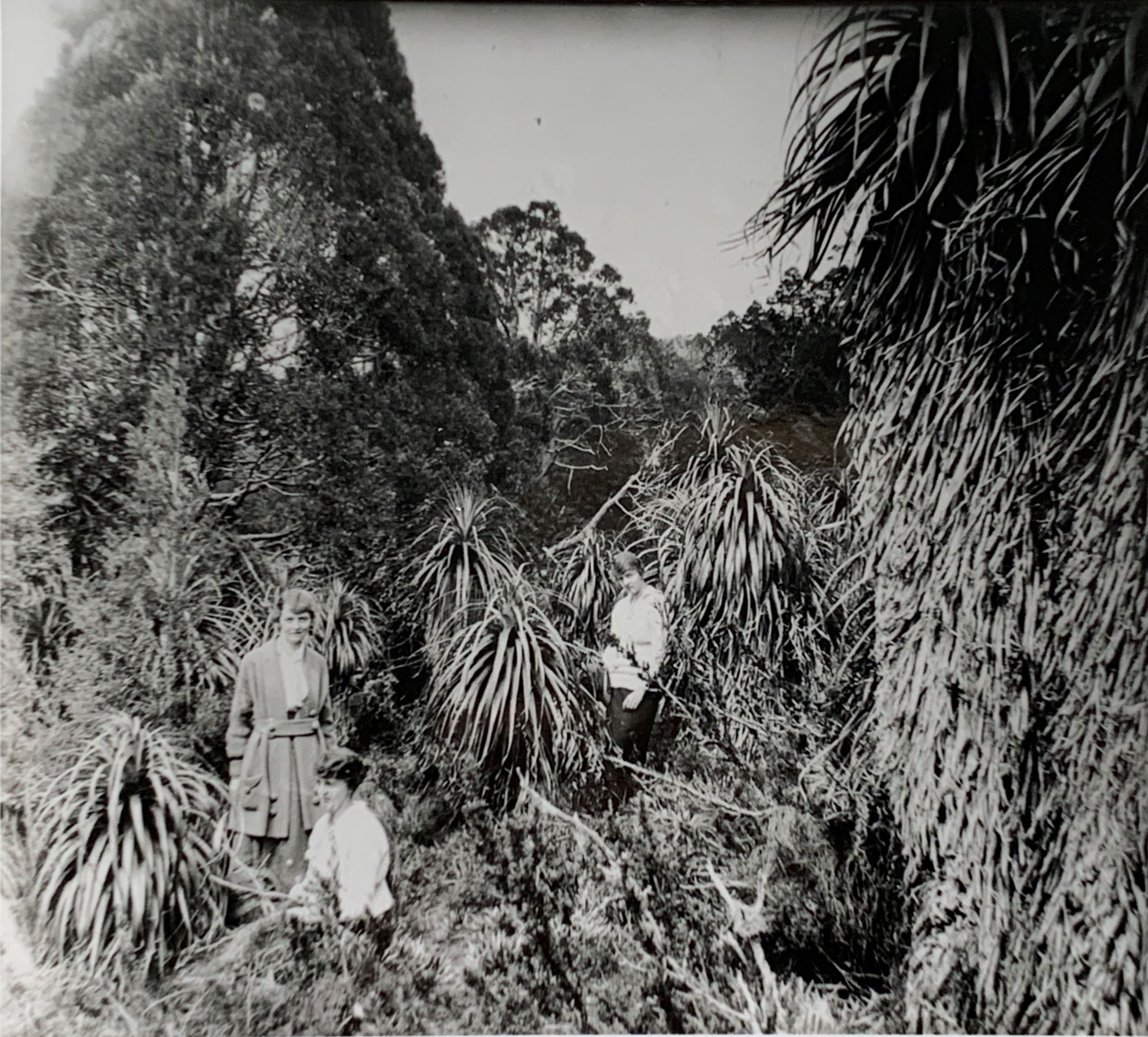
Richea pandanifolia in Cradle Valley. HJ King photo courtesy of the late Daisy Glennie.
From Claudia
My Dear Margaret,
I want to tell you of some of our walks. The first was in most glorious sunshine. We crossed the dear little creek that runs past the chalet and followed the steep moss-bordered path that winds up through the gulley [sic]. Here I made the acquaintance of the famous beech which is the only native tree that sheds its leaves.[27] Its slender graceful stem is beautiful and you have no idea how pretty, glimpses of the blue sky, looked through the canopy of little green leaves. I was quite sorry when we came up into the open but when we reached the top of Hampstead Heath we had a glorious view on all sides — the mountains in front and away back the way we had come to Middlesex.[28]
We went for the same walk again later but wandered further away over the hills and had a lovely picnic boiling the billy in the approved bush fashion. It was a delightful sight to see my rather stately Aunt Grace devouring a huge slice of bread and butter on which was spread a tinned herring and enjoying it too.
I think our lovliest {sic] picnic spot was a little pebbly speech on the shores of Dove Lake. The beauty of the spot and even the sight of Cradle frowning down upon us, failed to subdue the irrepressibles, who were madly engaged in getting as much of the beach as possible down each others’ backs. So to keep them quiet we set them to work getting our lunch. Our host had once been busy on that beach making a raft and the pair found too paddles roughly cut out of planks. These they seized and pressed into service as bread board and meat dish respectively. Mona soon had a nice little pile of bread and butter on one end of their respective paddles and solemnly marched round and served the waiting circle.
Soon we found ourselves climbing up the gently sloping sides of Mt Campbell. Half way up, we rested on a lovely fragrant couch of wild thyme[29] —So now I can say ‘I know a bank where the wild thyme grows’ because I do (Talking of resting, in this part of the world — if you want to rest where the ground is wet and it generally is wet, here we find you simply sit or lie on the strong stunted bushes growing about a foot above the ground and you have a seat fit for a Queen.)
As we pushed on up the mountain to our surprise we came across two or three snowdrifts. Of course each one was the signal for a scramble between the children (and I regret to say not wholly confined to them) but soon they came across an even more attractive diversion. Percy found a huge kerosene plant and promptly set fire to it.[30] It was really marvellous the way that green plant blazed and the intense heat it gave. Mona yearned to set fire to everyone she came across after that but her father wouldn’t hear of her spoiling the scenery in that fashion.
One morning we woke to find all the world white and the chalet a fairy place. We only got occasional glimpses of the Little Horn when her misty veil floated aside for a second, but those glimpses were beautiful indeed. Of course Mona and Percy were just spoiling for a snow fight and her father and I were dragged out to see fair play. At least that is what we intended, but we soon found ourselves involved in the battle and enjoying it mightily. The child’s delight in all was pretty to see, and so was the pride in her father’s eyes as they rested on the glowing face, alight with mischief and triumph as a well-armed snowball slipped down Percy’s neck. Our little Mona will be a very lovely woman some day. Ah me! What would it be to be sixteen and straight![31]
After peace had been declared we struck into the trees above the clear slope which had been the battlefield, and found a lovely little path winding among the trees towards the world. You have no idea how fascinating it is to stroll among the pretty floating flakes of snow. We felt quite injured when presently it turned to rain and sleet — it seemed commonplace. As we turned to retrace our steps Percy begged us to climb a tiny hill that lay between us and the ‘Dove’, directly facing Cradle. So up we climbed and there lay before us the Dove valley, Mount Campbell, the little foothills and Cradle, all one dazzling white vision of loveliness. I have only to shut my eyes and I can see it all once more. I wish you could, you would love it so.
Yours,
Claudia.
Dear Margaret,
It has been wet the whole day through. Mona was roaming restlessly round, poking her little nose into most things, when she came upon a printed notice on the roof ‘Special apartment for naughty girls’. Of course she immediately demanded the history thereof, and there was something very like a twinkle in the eyes of our host as he told the story of two unfortunate girls who had been imprisoned there. ‘And you too shall go up for you are the most naughty of them all’. There was a wild shriek from Mona, a frantic rush to the door, and then ensued such a scuffle as you never did see. When it was all over and Mona was safely in prison Mine host shook his head mournfully as he mopped his heated brow. ‘And she was the heaviest of them all.’ Then there was a shout of laughter for a shower of ancient Bulletins and Couriers came tumbling about his ears from the trap door above and Percy was promptly hoisted up to keep the rebel in order.
It was such evident cruelty to keep those two shut up that Uncle John proposed that we should take them for a walk, in spite of the rain. So off we set with one of the other visitors acting as guide to explore the valley in a new direction. First he led us into a most beautiful bit of virgin forest. Trees hundreds of years old towered above us.
Long ghostly locks of pale lichen hung from many of the smaller ones — I never saw such lovely moss and as I have seen here. Only once have we seen ferns in any of the glades, and those only of a common variety, but the mosses are exquisite. Presently we struck down into the opening and tramped briskly over the springy turf, the children wrangling away as usual.
Presently I made out that Percy was affirming his ability to make a big fire in the rain, and Mona was stoutly doubting.
We came to a little valley dotted with grass trees[32] and Percy stepped in front of a huge fellow, burrowed among the dried leaves around the trunk, set fire to them and waited. We watched breathlessly and soon saw a wicked little flame creeping up the trunk and in among the green leaves, and in a few moments great banners of flame were waving defiance to the rain. When we left, nothing remained of the beautiful green tree but a black smoking stump, and we were warned not to say anything about it on our return, as mine host doesn’t like the scenery spoilt. Neither do I, but all the same I am glad I saw it once.
One misty morning we started for the top of the Cradle. We had been looking forward to seeing the mountain lakes but the heavy mist hid everything. As we stood above what we were told was Crater Lake, occasionally we could see a thin silver line of foam, the mist would part for a second, allow us one weird glimpse of the lake then blot it out once more. By the time we had got within ¼ mile of the mountain’s foot the mist had turned to a fine thick rain, and the wind was icy, so a council of war was held and we decided to turn homeward by another route. In spite of the discomfort we enjoyed the experience — it was entirely new to us. It really was extremely funny to be tramping along in the fine rain and not worrying in the least, an inch of cold water swishing about in our boots, our faces perpetually washed but never dried, and drops of water hanging from brows, lashes, hair, chin — in fact anywhere they could cling. It is so strange to shut one’s eyes and fell the cold fringe of wet eyelashes. It was weird too, to look back and see mysterious indistinct figures, some armed with staves, looming in the distance. However we were soon safely home, into dry clothes, and grilling over the big home fire the chops we had expected to grill at the mountain’s foot.
Bed-time now so good-night.
Yours,
Claudia.
My Dear Margaret,
We had blackberry jam for tea, and it started us speaking of the occasional blackberry brambles we passed on our way here always beside a little stream, then someone said they had sprung up from seeds from blackberry jam used by prospectors camping there. Being in a dreamy mood I started picturing to myself the scenes round those camp fires — the rough hard faces lit up by the fitful flames, and from that I fell to musing over the glimpses we had had of lives so different from our own and the unexpected traces of history across which we had come. I could not help thinking what rich material a novelist might find here in the rough life of the mining settlements scattered among the hills — the lonelier camps away back in the mountains — the sawmill at Pencil Pine — the pioneer gang pushing their road into the mountains — the exciting rounding up of the magnificent wild cattle — the old life of the VDL Coy at Middlesex — the oldtime Governor [sic] who visited there — the convicts who toiled up the mountains laden with timber for the observation posts — the stalwart foreigner in his lonely chalet with its mysterious trap doors — the weather-beaten old man-councillor, — farmer, roadmaker [sic], miner, — his slender daughter with her sweet oval face and her hands full of golden lilies — or as we saw her later clad in rough trousers and boots for her work in the farm yard — her lover slipping along in the dusk to give her a helping hand. Why go to other lands for the setting for tales of adventure, of love, and mystery?
My dear! I have inflicted a screed on you. But we go home the day after to-morrow — that must be my excuse. Soon this freer and easy life — where ‘time is not [important] and nothing matters’, the porridge jazz, the wash up symphony, the picnics enlivened by the gambols [sic] of Flick and Flock, Mona and Percy, the fireside evenings of music and pleasant talk, the eagerly looked for coming of Mr Quaile with letters and papers, the meetings with visitors will be things of the past.
However often we come here in the future it will never be under quite the same conditions, and I am so glad we came before things are made too easy and ordinary for us.
Claudia.
MY DEAR MARGARET,
There is a touch of novelty about this letter. It is being written at the foot of Cradle — just as we started out I stuffed some paper and a pencil into my pocket in case I had a chance to write a line. We are just back from the summit and are resting before returning home. It has been a perfectly glorious scramble and I have enjoyed every minute of it. When we stood at the foot and looked up at the strange rugged pile I wondered if I could do it, but it turned out to be fairly easy. As we ascended our guide led us to the opposite side of the mountain and I felt a pang of disappointment as he began to go down, because I could see higher peaks above us. But it was only for a moment and then he began to ascend once more, passing over the lovliest [sic] little green velvety moss carpets. The view from the top is magnificent, we seemed to stand in a centre of ever widening circles of mountains. It was strange to stand on the cairn of tree trunks which we were told had been hauled and built up by convicts and think of the hard toiling hands that had placed them there, and to look at the wonderful view and think of the bitter, unhappy eyes that have gazed upon it before ours.
The scramble down gave us plenty of exercise and our hands were quite as useful as our feet; at the foot, one after the other down we went on hands and knees to drink from a tiny stream flowing from the hillside, and never was water sweeter. Mona seems pretty tired — don’t know what she will be like when we get home — she and Percy have been in such wild spirits that they have covered six times as much ground as anyone else. You know there is a lake on the way named after a Launceston lady,[33] and Mona was much taken by it and has been looking for something to which to tack her own name ever since. Well, she and Percy were for once walking quietly along conversing amicably when suddenly there was a wild shout and Percy darted off and began dancing wildly round a shallow swampy pool. When the rest of us came up he just gasped out ‘Mona’s Marsh’ and took to his heels with the indignant Mona after him like a deer. However she is quite happy now for a certain tiny muddy pool on the tableland bears the legend ‘Percy’s Puddle’ printed in big wobbly letters across its muddy bosom.
Claudia.
PS And oh, the lakes and the mountain are beautiful in the sunshine, but I am so glad we saw them first in their weird misty mood. C.

The Honeymoon Islands at the southern end of Dove Lake, with Beulah Hills on a pine driftwood and kerosene tin raft. Stephen Spurling III photo, 1922 (QVMAG).
My Dear Margaret,
It is 2 o’clock in the morning and I am sitting up in my bunk writing this by candlelight. I am far too happy to sleep so I will tell you of the wonderful thing that has happened. Mona was quite knocked up when we got back [from] Cradle and so it happened that I did not see the arrival of some new guests. I was busy putting her to bed and stayed with her till she was fast asleep. Then I slipped out to the group by the fire. Most of the men were so deep in the discussion of some mining affair that they did not notice me — all but one, quietly smoking and listening, on the edge of the group. He looked up and my dear! It was Dick! How long we stared at each other I do not know, nor how much of the wild gladness at my heart found its way into my face. But presently very quietly he rose, slipped back the curtain and drew me to the porch outside and oh my dear! Such a tangle of mistakes and misunderstandings we cleared up! All the happiness I ever dreamed of is mine. I know how glad you will be. And I am to be married to-morrow — no! It is to-day — I got into a panic at the bare idea but [Dick] only laughed at me and would have his way.
Yours Claudia,
(in a maze of happiness)
MRS JOHN MOORE TO HER SISTER.
My dear Mary,
The most unheard of thing has happened. Here we are at Wilmot and have left Claudia behind at that outlandish place. On our last night there John and myself happened to be left alone round the fire, when Dick Grey walked into the room and calmly asked John’s consent to marry Claudia next day.[34] He had turned up here early in the evening. Really for a moment I could only gasp. It appeared he met a parson staying at Daisy Dell as he came through and as it was bright moonlight, he proposed riding there at once, and bringing him here in the morning. I was really upset at the insane idea and as soon as I found breath enough I started straight for Claudia’s room. There she was, sitting on her bunk in the dark, ‘Claudia Crane, are you mad’? I demanded. When I had got the candle alight I could only gasp again. The little pale face was transfigured — flushed and smiling and sparkling the big eyes soft and shining. At sight of the radiant happiness shining in those eyes my irritation fell away like a garment. I did try to persuade her to come back to town and have a proper wedding but she was softly obstinate, she didn’t seem to think it mattered in the least that she had no trousseau or engagement ring or anything. And after all did it? As she had no relative nearer than ourselves, and we were all here, they were both old enough to be sure of themselves and they had wasted so much time already.

‘Starting for home from the Old Dump’, Bob Quaile at the reins of his horse team as he prepares to return a Waldheim party to Wilmot, 1925, with (left to right) Charlie Monds, Ron Smith and Gustav Weindorfer standing. Fred Smithies photo (TA).
Why should they wait longer? So I had to give in, for after all I had not the slightest right to object. When Mona heard the news in the morning, she was wild with excitement and promptly took charge with all girl’s delight in a wedding. She insisted on doing the thing properly, invited herself to be bridesmaid, and Percy to be the best man, hunted out the one soft little white frock Claudia had with her and fixed up a big tulle scarf of mine for a veil. A wreath of ginsen flowers and sweet scented white daisies nestled in the soft hair, holding the veil in place. My tender-hearted little girl had carefully draped it so that the slight deformity about which Claudia is so sensitive, was scarcely apparent. She had even a bouquet of lovely white berries she had found growing near the house. They were married out on the porch facing the mountain. Even to my eyes the little bride was as sweet as a rose, and it did my heart good to see the rather quiet face of her groom light up at sight of her and to see his eyes grow infinitely tender as they rested on the shy winsome face and I wish you could have heard the serene confidence in the low voice of the bride. After a gay little wedding breakfast, with one of Mr W’s huge slabs of cake in the place of honour, we started for home. It was quite in keeping with the rest of the up-side-down [sic] proceedings that we should be the ones to go (to the strains of the wedding march our host put on the Gramophone) leaving the bride and groom behind for their honeymoon and I am afraid they were not quite as sorry to see the last of us as they should have been — if they were the content in their faces belied them. I am afraid you will be inclined to blame me for lack of firmness but really I do not see how I could have acted differently.
Your affectionate Sister
Grace.
[1] Kate Legge, Kindred: a Cradle Mountain love story, Melbourne University Press, 2019.
[2] NS573/1/1/11 (Tasmanian Archives, afterwards TA).
[3] Maude van der Riet, ‘The Cradle Mountain: a climb to the peak: the world’s view’, Daily Telegraph, 15 December 1923, p.9.
[4] Waldheim visitors book, vol.1, 1991:MS:0004 (Queen Victoria Museum and Art Gallery).
[5] Electoral roll, Division of Bass, Subdivision of Launceston West, 1922, p.31; entry for Harriet Mary (Addie) Cumings, Launceston Family Album, written by Lesley Morgan Blythe and Marion Sargent, https://www.launcestonfamilyalbum.org.au/detail/1030945/harriet-mary-addie-cumings, accessed 10 June 2023.
[6] Electoral roll, Division of Bass, Subdivision of Launceston West, 1922, p.43. Piper married Ada Letitia Isabel Scott, unrelated to Vera May Scott, in 1923.
[7] Years are from headstone, Carr Villa Memorial Park, Launceston; plus 1901 British Census as below.
[8] British Census, 1901, Administrative County of London, Civil Parish of Heathorn, p.22 (accessed through Ancestry.com.au).
[9] Electoral roll, Division of Bass, Subdivision of West Launceston, 1922, p.48. See also will of Henry Sidney Scott, in which he made his daughter Vera May Scott his sole executrix and beneficiary, will no.18727, AD960/1/56 (TA).
[10] ‘Thanks’, Examiner, 23 October 1945, p.2.
[11] See will no.43508, AD960/1/94 (TA).
[12] Years are from headstone, Carr Villa Memorial Park, Launceston.
[13] Passenger list for the Orana, October 1891, Series BT27, British National Archives (accessed through Ancestry.com.au).
[14] Electoral roll, Division of Bass, Subdivision of Launceston Central, 1922, p.34.
[15] Electoral roll, Division of Bass, Subdivision of Launceston Central, 1968, p.16.
[16] Descriptive list of immigrants, ss Coptic, arriving in Hobart 27 July 1888,. CB7/12/1/12–13, p.40 (TA), https://librariestas.ent.sirsidynix.net.au/client/en_AU/names/search/results?s=harriet+cumings&searchTarget=library&qu=harriet&qu=cumings, accessed 10 June 2023.
[17] ‘Current topics’, Launceston Examiner, 13 May 1893, p.5.
[18] See, for example, ‘Education’, Launceston Examiner, 4 January 1893, p.2; ‘Educational’, Daily Telegraph, 21 January 1896, p.4; ‘Diamond jubilee’, Launceston Examiner, 15 June 1897, p.6.
[19] Married 21 January 1903, registration no.608/1903, at St Paul’s Church, Launceston (TA).
[20] Gustav Weindorfer to RE Smith, 20 March 1920, NS234/17/1/4 (TA).
[21] Bob Quaile (1862–1942) was a well-known Wilmot identity, whose farmhouse just north of the village remains today as a barn. Quaile did much to open up Cradle Mountain as a tourist destination. For many years he operated a horse and wagonette service to Waldheim which was Gustav Weindorfer’s lifeline, the trip being broken at Quaile’s halfway house Daisy Dell. Quaile was a Kentish councillor and member of the Cradle Mountain Reserve Board.
[22] In 1922 Quaile had only one unmarried daughter, Sarah Ellen Quaile, born in 1897 and therefore 25 years old at the time of the Joscelyne party’s visit to Waldheim.
[23] Quaile was not a miner but had shares in the revamped Great Caledonian Gold Mine at Middlesex.
[24] The Great Caledonian Gold Mine.
[25] The FH Haines sawmill was on the site of the present-day Peppers Cradle Mountain Lodge.
[26] That is, Percy Lane’s father was involved in the Tasman Oil Company mine at Barn Bluff.
[27] Nothofagus gunnii.
[28] Claudia is describing the track through what is now known as Weindorfers Forest to Hounslow (not Hampstead) Heath. Weindorfer’s track was later replaced by the present track in that direction, cut by Lionel Connell and his sons.
[29] Lemonthyme (Boronia citriodora). It has a strong scent which some liken to that of lemon.
[30] Several Tasmanian plants seem to have borne the colloquial name ‘kerosene bush’ because of their flammability, but here the author seems to be referring to Richea pandanifolia.
[31] Claudia refers to her physical form rather than her sexual orientation!
[32] Richea pandanifolia.
[33] The ‘lake named after a Launceston lady’ is Lake Lilla, named by Stephen Spurling III after his sister in 1905.
[34] The idea of a Waldheim wedding was perhaps inspired by the legend of the naming of the Honeymoon Islands in Dove Lake. Weindorfer is meant to have rowed a couple to this improbable honeymoon spot, serenading them as he dipped the oar.
by Nic Haygarth | 13/06/20 | Tasmanian high country history, Tasmanian nature tourism history
When I was a Tasmanian child the school-ma’amish Mrs Marsh demonstrated the mastery held by Colgate toothpaste over a piece of chalk. Or something. ‘It gets in?’, chirped this harridan’s childhood charges, as she pulled the chalk from a bottle of red dye and snapped it in half. Sure enough, the red dye had suffused the chalk. Apparently it did get in.
Quite what this had to do with the whitening powers of toothpaste was and is beyond me, but I still thought of her when, abandoning the TV, I gazed at Black Bluff gleaming on the skyline. If ever a mountain had the Colgate ring of confidence it was this one. Its winter coat seemed brighter, thicker and longer-lasting than those of Mount Roland and Western Bluff. Of the peaks I saw regularly during the course of my north-west-coastal school days only Mount Ironstone, behind Deloraine, rivalled it as a snow-cone.
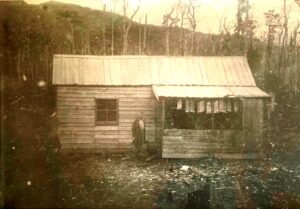
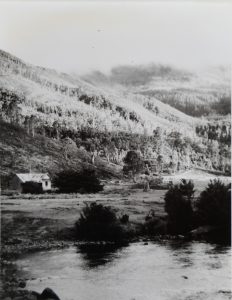
(Top) George (GP) Taylor at a one-room Levenvale, Taylors Flats, Loongana, 1926. (Above) Later he added another gable containing a second room. The head of Black Bluff is lost in cloud. Photos by Ron Smith and Chris Binks respectively.
So I wasn’t surprised to learn that, in the late 1920s and 1930s, when Tasmanians began to attack their peaks on homemade skis and toboggans, Black Bluff came in for some serious scrutiny. In the winter of 1928 Ulverstone jeweller and photographer George (GP) Taylor and Cradle Mountain Reserve Board Secretary Ron Smith climbed the bluff to test its suitability for winter sports. ‘In frosty weather after a fall of snow’, they wrote, ‘skiing and tobogganing could be carried on successfully, and the accessibility of the mountain from the coast should make it a popular winter resort, provided sufficient accommodation is available on the mountain’.[1]

Base map from LISTMap, courtesy of DPIPWE.
The Ulverstone Tourist and Progress Association had surveyed a Black Bluff track from near Taylor’s Loongana shack Levenvale, but on the back of this report the Public Works Department’s Paddy Doyle cut a better one (the Brookes Track) which opened in January 1930.[2] Further afield near Cradle Mountain, Waldheim Chalet tourism operator Gustav Weindorfer must have noted events at Black Bluff apprehensively. For years he had been encouraging the development of hiking and winter sports at Cradle Mountain with modest return. Both were starting to take off now, but a new mountain playground at Black Bluff—a place you could park your car under—might scotch his business.
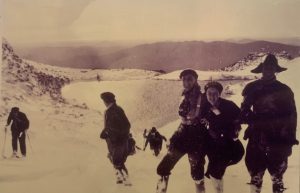

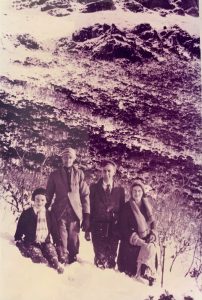
Action from the ski club’s first outing on 26 June 1932. (Top) Jack Breheny, Lola Vollprecht and Sid Butler on the ski slope above Paddys Lake. (Middle: left to right) Sid Butler, NB (‘Darkie’) Wilson, Bill Mitchell, Jack Breheny, Lola Vollprecht, Peter Roger-Jones, Gifford Brownrigg, club secretary George Cruickshank, Cecil Rawson, Vince Taylor and (far right) club president George Taylor. (Above): Stella Pemberton, Gifford Brownrigg, George Cruickshank and Mrs Gillam climbing the Brookes Track near the later chalet site.
Photos courtesy of the late Jack Breheny.
As it turned out, Weindorfer was in his grave by the time Ulverstone enthusiasts pressed the issue of forming a ski club.[3] The club took its cues from the Legges-Tor-based Northern Tasmanian Alpine Club (NTAC), dubbing itself the North West Alpine Club. The club’s first outing was in June 1932, when a delegation from the NTAC consisting of Jack Branagan, Reg Hall, Bill Mitchell and Eileen Perrin visited Black Bluff in tandem with about 50 local members.[4] Taylor’s two-room Levenvale, 90 minutes by car from Ulverstone, seemed an ideal base camp, with skiers relaxing by its roaring fire and in its bunks. Even veteran skier ET Emmett threatened to test the new ski field.[5] As was the case at Cradle Mountain, conditions were not often optimal for skiing, but another successful outing was staged on 6 August 1933.
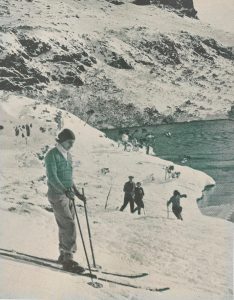
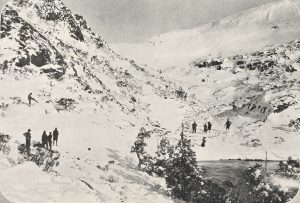
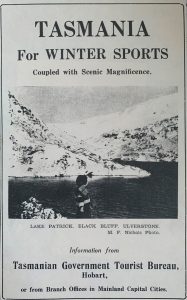
(Top and middle) Skiers on the slope above Paddys Lake during the 1932 season; and (above) the Tourist Bureau uses a photo of Black Bluff skiing to promote winter sports during the 1930s. All three are Mel Nichols photos. Top is from the Illustrated Tasmanian Mail, 1 December 1932; centre from the Weekly Courier, 13 July 1932, p.24.
In 1935 an enlarged club rode ‘a wave of enthusiasm and activity’.[6] Some of that was directed at changing the club’s name to the Black Bluff Ski Club and erecting a twelve-bunk ski chalet at a spot below Paddys Lake known as Boozers Rest.[7] Benefiting from a £15 Tourism Department grant, club members split timber and hauled it up to the 950-metre mark, and during the winter and spring of 1935 working bees soon completed the two-room hut with spacious fireplace.[8]
This, surely, would bind members socially just as the NTAC had bonded over chalet building. Skiers now had a refuge from the weather and, conveniently, skis and toboggans could be left on the mountain. What could possibly go wrong?
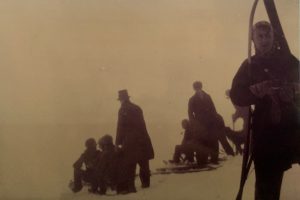
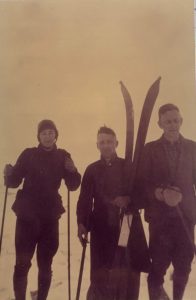
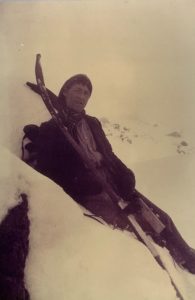
(Top) Tobogganing on the saddle above Paddys Lake, 6 August 1933. (Middle) George Hodgkinson, Jack Breheny and George Cruickshank on the ski slope. (Above) Bill Breheny takes a break above Paddys Lake. Photos courtesy of the late Jack Breheny.
A few things. World War Two (1939–45) played a part in the club’s fortunes. While Hobart and Launceston were no closer to their ski fields than Ulverstone, they had bigger population bases to draw upon in the event of the original enthusiasts petering out, moving on or mobilising as part of the war effort. However, something else preceded that. In winter with snow on the ground and ice on the lake it was probably hard to imagine a bushfire roaring down on the chalet, but that is exactly what happened in mid-summer, January 1939. The building was destroyed. The ‘boozers’ lost their roost.[9] There was no impetus to rebuild even in the post-war period when nature sports and studies boomed. Now you can drive to a ski field—why climb?
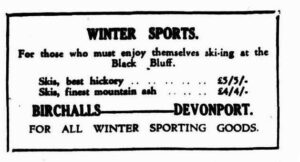
Mrs Marsh probably knew nothing of climate change, and the effect it had on toothpaste … or snowfall. Unreliable snowfalls are the bugbear of skiers, but in my child’s eye Black Bluff still has its pearlies out, beckoning those bright young things who knew how to Charleston and how to wear a sou’wester.
[1] GP Taylor and RE Smith, ‘Black Bluff Mountain: winter sports and mountaineering near Ulverstone’, 21 August 1928, report to the Tasmanian Government Tourist Bureau.
[2] ‘Ulverstone: Black Bluff Track opened’, Examiner, 28 January 1930, p.5.
[3] ‘NW Tasmanian Alpine Club’, Australian and New Zealand ski year book, New South Wales Ski Council, Sydney, 1933, p.228.
[4] ‘Mountain sports’, Mercury, 29 June 1932, p.5.
[5] ‘Winter sports: visitors to Tasmania’, Mercury, 22 July 1932, p.6.
[6] ‘Black Bluff Ski Club’, Australian and New Zealand ski year book, New South Wales Ski Council, Sydney, 1935, p.234.
[7] ‘North West Alpine Club’, Advocate, 22 May 1935, p.6; ‘Ski club hut’, Advocate, 25 May 1935, p.6.
[8] ‘Ulverstone’, Advocate, 27 June 1935, p.6; ’Black Bluff hut’, Advocate, 17 July 1935, p.6; ‘Trip to Black Bluff’, Advocate, 3 September 1935, p.6.
[9] GP Taylor, ‘Bush fires’, Advocate, 30 January 1939, p.6.
by Nic Haygarth | 11/08/17 | Tasmanian high country history, Tasmanian nature tourism history
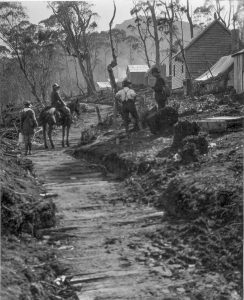
Main Street Adamsfield, 1926, with Ida Smithies and Florence Perrin. Fred Smithies photo courtesy of the Tasmanian Archive and Heritage Office.
In November 1926 a Mrs Gresson advertised tourist accommodation at the Tasmanian mining settlement of Adamsfield: ‘See Tasmania’s Wild West, the “osie” diggers, Adams Falls, Gordon Gorge’.[1] What extraordinary enterprise for a simple digger’s wife 120 km west of Hobart! However, when you learn what an extraordinary woman Lily Gresson actually was, this visionary behaviour comes as no surprise at all.

A water race and the village of Adamsfield, 1926, Fred Smithies photo courtesy of the Tasmanian Archive and Heritage Office.
Her old school Airbnb advert was probably shaped by two events: meeting the one-man promotional band Fred Smithies; and a memorable outing she made to the nearby Gordon River Gorge. Visiting Adamsfield by horseback and pack-horse in February and March 1926, Smithies, an amateur tourism promoter, had snapped the town and its jagged skyline for his travelling lantern-slide lecture ‘A trip through the wilds of the west coast and the osmiridium fields’. ‘Gorges of inspiring grandeur’ and ‘magnificent mountain scenes’ also transfixed Gresson. Decades later she recalled that
‘the scenery to the Gordon River was indescribable. Peak after peak of snow-capped mountains and the Gordon Gorge was so precipitous we would scarcely see the bottom … [it] … was like so many battlements’.
Her party ‘cheerfully stalked along the ten miles of wonderful scenery singing bits of popular songs. This was the first time I had heard [‘]Waltzing Matilda[’], she recalled, ‘and it certainly cheered and helped us along, and home again, when we’—Lily and her husband Arthur Gresson, a veteran of the Siege of Mafeking during the South African War— ‘were beginning to flag’.[2]
Certainly the outing would have come as welcome relief from the routine of life on the Adamsfield diggings. The Gressons had rushed to Adams River in the spring of 1925, after the Staceys from the Tasman Peninsula and their mates struck payable osmiridium. Lily was a woman of great conviction. At a time when few women dared venture among the thousand or so men on the ossie field, she secured her own miner’s right, put together a side of bacon and other requisites, bundled her twelve-year-old son Wrixon onto the train and off they went to Fitzgerald, the western terminus of the Derwent Valley Line, to join Arthur.
Fitzgerald was still 42 km from Adamsfield. Meeting his family there, Arthur hired five horses, including one for Wrixon, who had never ridden a horse before, one for the packer and another to carry the three months’ supply of food and equipment. It was snowing. In parts of the Florentine Valley the mud was up to the horses’ girths, Lily recalled,
‘and they slithered, slipped and plunged into the side track to keep themselves steady. The track was narrow, hastily prepared in very thick scrub, corduroyed also hurriedly—the edges not even adzed. I pitied the poor ‘gees’ [horses] slipping and floundering to try and gain firm footing. I thought I would soon be slipping over their heads and called out to my husband, “Shall I dismount?” “Certainly not”, was the reply, “or you will never get up again.” So I stayed on as best I could following the packer’s lead, for I was behind him. Presently, just around the corner, he shouted, “Look out, the down packs are coming!”’[3]
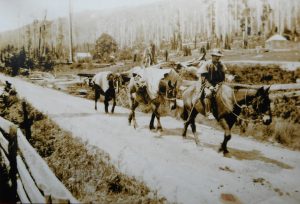
A packer leading a pack-horse team out of Fitzgerald, taking supplies into Adamsfield, 1925. Alf Clark photo courtesy of Don Clark.
This was pack horses returning unsupervised from Adamsfield. When the osmiridium field was reached, the horses were simply released to find their own way back down the track to Fitzgerald. Given that there was no feed between the two centres, the hungry animals galloped wherever they could, a nasty surprise for the uninitiated coming the other way. How the horses survived the return trip without a broken leg is hard to imagine.
The Gresson party stopped for the night at Chrisp’s Hut, a leftover from the 1907 Great Western Railway Survey.[4] It took a further day to reach Adamsfield over the ranges. The mining settlement was ‘a busy seething mass of men and horses, to say nothing of a vast morass of mud, with short stumps sticking up everywhere, quite enough to topple us over’. Arthur Gresson was living in the sort of tent-hut typical of a temporary miner’s quarters. Wrixon slept on a bench in a bark humpy with only a hessian curtain to keep out the cold, while his parents bunked down under a tent fly.
Having obtained the miner’s right, Lily was entitled to peg her own claim measuring 50 yards by 50 years (that is, about 45 metres square), and she set out next morning suitably attired in her lace-up mining boots, riding breeches, short coat and emerald-green rain hat. After she had dug a hole almost two metres deep and obtaining osmiridium-bearing earth, a man ‘jumped’ her claim, taking all the valuable ‘wash’ before she even knew it had happened. Arthur Gresson sent the intruder packing, but the damage was done, and Lily had to start again on a new claim. Soon she was winning tiny nuggets of coarse ‘metal’ by sluicing the ‘wash-dirt’.[5]
The Gressons remained at Adamsfield through the tough winter of 1926, when the diggers tried to counteract a reduced osmiridium price by selling their metal directly to London. It was tough going through that winter. Many left the field, while others stayed and suffered. Lily recalled the time nineteen-year-old digger Maxwell Godfrey went missing on an icy-cold night. He curled up under a log in the bush, but his legs were frostbitten. Nurse Elsie Bessell, who had only a tent for a hospital, could do little for him, and the news got no better after he was stretchered out to Fitzgerald, slung between two horses. Both his legs were amputated below the knee.[6] A public subscription raised about £500 to help him, and soon he was walking again with the aid of prosthetics.[7]
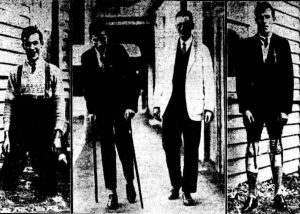
Maxwell Godfrey walks again, from the Mercury, 24 May 1928, p.5.
Lily Gresson, who had had some nursing experience in London, again showed her versatility by looking after the two patients in the hospital while Nurse Bessell accompanied the incapacitated man out to the railway station. Perhaps Lily also home schooled thirteen-year-old Wrixon. There were few children and no school at Adamsfield at this time, so otherwise he would have lost a year of his education.
And the Gressons’ Air B’n’B house? Well, while it was hardly the Adamsfield Hilton, it was comfortable enough by mining frontier standards—a paling hut with a big fireplace and a real glass window.[8] Lily Gresson might have been just a little ahead of her time. Hikers would soon be on their way to Adamsfield and the glorious south-west beyond. Ernie Bond would be besieged with them at times on his Gordon River farm, Gordon Vale, during the 1930s and 1940s. In 1952 the Launceston and Hobart Walking Clubs would even inherit Gordon Vale. Lily Gresson , pioneer of the Adamsfield diggings, was onto something!
With thanks to Dale Matheson, who showed me this story.
[1] ‘Board and residence’, Mercury, 23 November 1926, p.1.
[2] Lily Gresson; quoted by Fred A Murfet, in Sherwood reflections, the author, 1987, p.194.
[3] Lily Gresson; quoted by Fred A Murfet, in Sherwood reflections, p.190.
[4] In her account, Lily Gresson did not mention the notorious ‘Digger’s Delight’, the sly-grog shop and accommodation house that accompanied Chrisp’s Hut soon after the Adams River rush began. Perhaps Ralph Langdon and Bernie Symmons had already moved on into down-town Adamsfield, building Symmons Hall with its accompanying illegal boozer.
[5] Lily Gresson; quoted by Fred A Murfet, in Sherwood reflections, p.192.
[6] ‘Bush nursing’, Mercury, 22 July 1926, p.11; Elsie G Bessell, quoted by Marita Bardenhagen, Adamsfield bush nursing paper, presented at the Australian Mining History Association conference at Queenstown, 2008; ‘Sufferer in bush’, Mercury, 24 May 1928, p.5.
[7] ‘Maxwell Godfrey Fund’, Mercury, 27 July 1927, p.3; ‘Maxwell Godfrey walks again’, and ‘Sufferer in bush’; both Mercury, 24 May 1928, p.5.
[8] Lily Gresson; quoted by Fred A Murfet, in Sherwood reflections, p.192.
by Nic Haygarth | 21/01/17 | Tasmanian high country history, Tasmanian landscape photography, Tasmanian nature tourism history
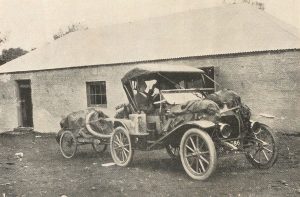
Starting out from the Ouse River in the Hupmobile, 1914-15 trip. Ray McClinton photo from the Weekly Courier, 28 January 1915, p.18.
It was the first motor trip to Lake St Clair. In 1915 pioneering motor tourers Ray and Edith McClinton mounted a two-week expedition from Launceston to the highland lake, with ‘Nina’, social pages and women’s editor of the Weekly Courier newspaper, as their guest. The Hupmobile party, towing an additional 120 kg of motor boat engine and luggage, battled rocks, ruts, rain and button grass up the Derwent Valley, breaking their trip at Ouse, the Ellises’ house near the Dee River, Weeding’s at Marlborough and Pearce’s at the Clarence River.[1]
McClinton, a San Francisco dentist who with his wife lived in Launceston 1904–28, would soon become one of Tasmania’s great tourism ‘boosters’.[2] Like fellow Launceston rev-heads Stephen Spurling III, Fred Smithies and HJ King, McClinton worshipped both nature and technology. He wanted to crash deep into the highlands, breaking down the physical and virtual isolation with carburettors and cameras. He was also imbued with fervour for worthy objects and the nineteenth-century tradition of public education that made him a consummate lantern slide lecturer on anything from x-raying teeth to colour photography.[3] Soon he would turn those skills to promoting Tasmania’s scenic wonders. Visiting Lake St Clair was one of the foundation stones of his eventual campaign in support of plans for a Cradle Mountain-Lake St Clair national park.[4]
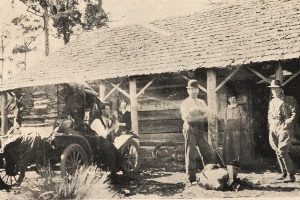
The Hup party at the government log cabin, Cynthia Bay, Lake St Clair, 1914-15 trip, with the unmistakable figure of Paddy Hartnett closest to the camera. Ray McClinton photo from the Weekly Courier, 28 January 1915, p.18.
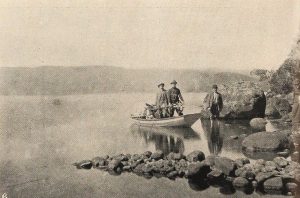
The motorboat and Paddy Hartnett in the lake, 1914-15 trip. Ray McClinton photo from the Weekly Courier, 28 January 1915, p.18.
Already there was rudimentary infrastructure at the lake. The Hup party took advantage of the government-built three-room log cabin at Cynthia Bay. On foot at last they crossed the Cuvier River on a rustic bridge. McClinton attached his engine to the boat at the lake, enabling communication with the Perrin party —a pedestrian party—camped near the Narcissus at the northern end of the lake. Highland guide Paddy Hartnett had led them to Lake St Clair via the Mersey River.[5] ‘Nina’ marvelled at the reflections in the Narcissus River and the gambolling of a platypus. She made even the ‘perfume of petrol’ mingle poetically with the ‘sweet scent of the woods’, as the first propeller churned the waters of Lake St Clair. A storm disrupted the return journey down the lake but, with the aid of axe, saw, lamp and candles, McClinton soon fashioned ‘Nina’ a comfortable bower in the forest:
‘Imagine myrtle trees towering over a hundred feet high, and their branches interlaced, so that only patches of sky could be seen above, and only glimpses of the lake between. Then picture tree-ferns all around, and green moss for a carpet. Add to his a vision of remnants of fallen trees of age untold, coated with moss inches thick, like green plush. The imagine crystal streams trickling down the mountain side … The whole scene was fairyland …’[6]
But who was ‘Nina’? She was an outstanding journalist called Kate Farrell, better known by her pseudonyms ‘Nina’ and ‘Sylvia’. Her literary career spanned 33 years and included both Launceston dailies, the Daily Telegraph and the Examiner, plus their respective weekend newspapers, the Colonist and the Weekly Courier.[7] The scale of her anonymity can be tested quite easily by searching the Trove digital database: during her literary career c1894–1927 the name Kate Farrell has only 7 hits, while ‘Woman’s World’ by ‘Sylvia’ occurs 1933 times.[8] ‘Woman’s World’ was generally frocks, recipes and home hints. In 1914 Farrell published her 96-page Sylvia’s cookery book.[9] During World War One she turned her attention to bringing comfort to those at the front, and she was also a ‘booster’, penning tourist guide The charm of the north in 1922.[10] Farrell had been motor touring with the McClintons for years, having accompanied them to Lake Sorell in their Winton Four and on Edith McClinton’s one-woman non-stop run from Launceston to Richmond in the Hupmobile. [11] Farrell preceded Ray McClinton as a tourism ‘booster’, and at Lake St Clair she quickly got into her stride:
‘The beauty of the scene is inexpressible. One can imagine the crowds of tourists who would visit Lake St Clair if the road were made. A number of small chalets built, with a caretaker in charge, and a motor boat available for the use of visitors, would help matters along considerably. I hope it will not be long before such dreams come true’.[12]
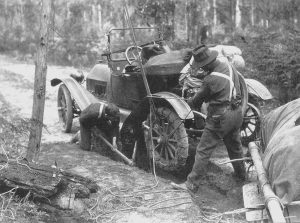
Stuck in a wash-out near Ellendale, 1916-17 trip, King and McClinton in action. HJ King photo courtesy of Daisy Glennie.
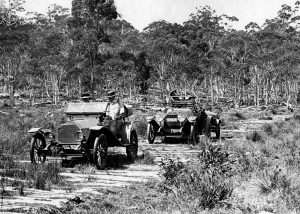
The Hupmobile, containing the two ladies, and McClinton in the ‘Baby Grand’ Chevrolet, posed as if tackling the corded track, 1916-17 trip. HJ King photo courtesy of Maggie Humphrey.
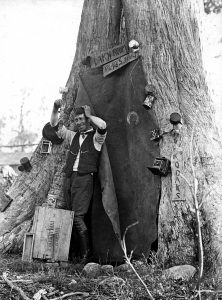
‘The darkroom at Lake St Clair’, HJ King despairs over the photographic facilities, 1916-17 trip. HJ King photo courtesy of Maggie Humphrey.
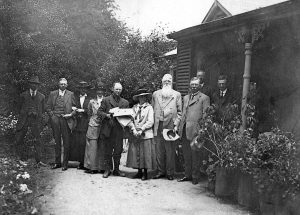
The 1916-17 party at Bushy Park, Sir Philip Fysh with the white beard, the McClintons at centre, with Kate Farrell fourth from left. Bushwalker and park administrator WJ Savigny is second from left. HJ King photo courtesy of Maggie Humphrey.
The McClintons and Farrell repeated their Lake St Clair excursion two years later, this time with the established amateur photographer HJ King. While King drove McClinton’s faithful old Hupmobile (registration number 586), the dentist was at the helm of his new ‘Baby Grand’ Chevrolet (number 4465). Both vehicles survived—but, in the true tradition of motor touring, it was a near thing for much of the way. The government accommodation house had been destroyed by fire in the intervening two years. However, rather than repeat herself, Farrell minimised her tourism boosting and concentrated on describing the route taken and the social pleasantries of a visit to former premier Sir Philip Fysh’s Bushy Park estate.[13] The real reporter was King. McClinton deferred to the superior shutterbug, allowing him to be the official tour photographer, and many King photos from this trip appeared in the Weekly Courier during 1917, including his light-hearted ‘Lake St Clair Darkroom’.[14] King’s keen eye captured the logistical difficulties of the corrugated track, with block and tackle deployed near Ellendale, some pick and shovel work on the Sandhill at Lawrenny and rescue by a bullock team near Derwent Bridge. McClinton also appears to have had a long stint with a hand saw clearing a fallen tree. One of the most interesting images from the trip was McClinton, the ex-patriate American, recalling his military training by posing with a gun upon his shoulder, as if guarding the beauty of Lake St Clair.[15] How far they were from the European War (King was a conscientious objector, McClinton effectively neutral), yet the connection remained even here.[16]
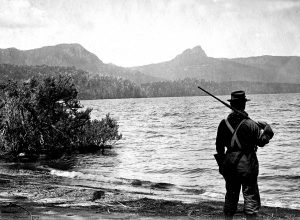
Ray McClinton posed militarily in front of Mount Ida, 1916-17. HJ King photo courtesy of Maggie Humphrey.
‘To Lake St Clair with car and camera’ became one of first outings of the McClinton–King lantern lecturing team.[17] Later, with Fred Smithies, they would add Cradle Mountain and the Pelion region to their lecturing repertoire. At her retirement in 1927 Kate Farrell was ‘Launceston’s senior press woman’ and the last of the Weekly Courier’s original staff. [18] The McClintons were there to farewell her, just ahead of their departure from Tasmania.[19] Farrell died in 1933, after a long battle with illness, leaving only King to enjoy the road they had craved, the ‘missing link’—forerunner of the Lyell Highway—between Marlborough and Queenstown.[20] By then Lake St Clair was well on its way to becoming a tourism hub.
[1] See ‘Nina’ (Kate Farrell), ‘A trip to Lake St Clair’, Weekly Courier, 21 January 1915, p.29; 28 January 1915, pp.27–28; 4 February 1915, pp.28 and 29; and 11 February 1915, p.28.
[2] Edith McClinton actually left Tasmania for Honolulu in June 1927 (‘Social notes’, Daily Telegraph, 22 June 1927, p.2), Ray MClinton joining her there in November 1928 (‘Dr Ray McClinton’, Mercury, 8 November 1928, p.11).
[3] See, for example, ‘X-rays and the teeth’, Examiner, 18 June 1925, p.5.; and ‘Local and general’, Daily Telegraph, 5 July 1923, p.4. For Launceston rev-head photographers generally, see Nic Haygarth, The wild ride: revolutions that shaped Tasmanian black and white wilderness photography, National Trust of Australia (Tasmania), Launceston, 2008.
[4] McClinton and Smithies had visited the Du Can Range area in 1913, and may have visited Lake St Clair at that time, but that was a pedestrian trip.
[5] See ‘The adventures of Paddy’s Gang: an account of a Perrin family trip to Lake St Clair guided by Hartnett over the Christmas–New Year period in 1914–1915’, diary in possession of Bessie Flood.
[6] ‘Nina’ (Kate Farrell), ‘A trip to Lake St Clair’, Weekly Courier, 28 January 1915, p.28.
[7] ‘Miss K Farrell’s death’, Examiner, 4 July 1933, p.9. Thanks to Ross Smith for identifying ‘Nina’.
[8] The Weekly Courier is not yet indexed on Trove, making it impossible to search on ‘Social notes’ by ‘Nina’. Propriety of the time contributed to this disparity, insisting that she be referred to simply as ‘Miss Farrell’ throughout her life.
[9] ‘Social notes’, Daily Telegraph, 25 May 1927, p.2. The full details are K Farrell, Sylvia’s cookery book: tested recipes and items of interest, Launceston, 1914.
[10] K Farrell, The charm of the north, Launceston City Council, Launceston, 1922.
[11] ‘Nina’ (Kate Farrell), ‘Camping at Interlaken’, Weekly Courier, 21 January 1909, p.29; ‘Exhaust’, ‘Motor notes’, Daily Telegraph, 9 November 1911, p.11.
[12] ‘Nina’ (Kate Farrell), ‘A trip to Lake St Clair’, Weekly Courier, 11 February 1915, p.28.
[13] ‘Nina’ (Kate Farrell), ‘A trip to Lake St Clair’, Weekly Courier, 11 January 1917, p.27. The trip was also written up by ‘Spark’ (Charles George Saul), ‘Motoring’, Examiner, 13 January 1917, p.4. Thanks to Ken Young for identifying ‘Spark’.
[14] See Weekly Courier, 11 January 1917, p.17; 18 January 1917, p.18; 25 January 1917, p.17; 1 February 1917, p.17; 15 February 1917, p.17; 22 March 1917, p.20; 5 April, pp.17, 20 and 21; 31 May, p.21; 13 September, p.17; 18 October 1917, p.17; and 1 November 1917 (Christmas issue), p.22.
[15] Ray McClinton performed military training 1900–02 in California, film no.981549, MF4:2, National Guard Registers v.61, 1st Infantry, 2nd Brigade, Enlisted Men, 1883–1902, California, Military Registers, 1858–1923.
[16] McClinton supported the Allied war effort, but America did not enter World War One until April 1917.
[17] See ‘Spark’ (Charles George Saul), ‘Motoring’, Examiner, 3 February 1917, p.4; ‘Plug’, ‘Motor notes’, Daily Telegraph, 13 February 1917, p.6.
[18] ‘Journalist honoured’, Examiner, 24 May 1927, p.7, ‘Social notes’, Daily Telegraph, 25 May 1927, p.2.
[19] The McClintons’ names were accidentally omitted from the Examiner’s story of this event. See the correction, Examiner, 25 May 1927, p.7.
[20] ‘Miss K Farrell’s death’, Examiner, 4 July 1933, p.9.
by Nic Haygarth | 14/01/17 | Tasmanian high country history, Tasmanian landscape photography, Tasmanian nature tourism history

‘The darkroom at Lake St Clair’, HJ King despairs over the photography facilities, 1917. HJ King photo, courtesy of Maggie Humphrey.
The young Herb (HJ) King was a rev-head with an artist’s eye, a man beguiled by cameras and carburettors. The frontage of his father’s motorcycle shop, John King and Sons, which he eventually took over, remains a landmark of the Kingsway, off Brisbane Street, Launceston, long after it closed. In 1921 the rival Sim King’s motorbike shop at the other end of Brisbane Street ran an advert for machines with ‘double-seated’ sidecars: ‘Take her with you!’[1] That is exactly what Herb King was already doing, the sight of his wife Lucy in the sidecar of his Indian motorbike becoming a signature of his photography in the period 1919–25.
It was perhaps King’s conservative Christadelphian faith that determined that he marry young, have children and place the role of family man before all else. He married Lucy Minna Large in Hobart in December 1918. Lucy recalled that King drove her father from Hobart to Launceston. Alighting from the car, Charles Large said ‘Oh, my boy, it’s a long way’, to which King replied, ‘Yes, Charles, what about letting Lucy and I get married at Christmas, instead of waiting?’ She was eighteen years old. He was 26.[2]
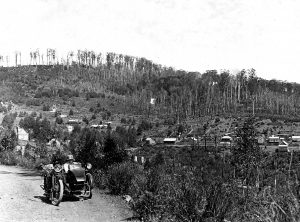
Lucy in the sidecar at Moina, just off the Cradle Mountain Road, 1919. HJ King photo courtesy of Maggie Humphrey.
After this, before their first child was born, Lucy was a feature of King’s photography, accompanying him on most of his photographic trips. King got to Cradle Mountain slightly ahead of his nature-loving friends Fred Smithies and Ray McClinton. In December 1919 Herb, Lucy, her sister and a friend started for Cradle on motorbike and sidecar. After staying a night at Wilmot, they had Christmas dinner at Daisy Dell, Bob Quaile’s half-way house, with Lucy making a success of her first Christmas pudding. The track from Daisy Dell across the Middlesex Plains to Cradle Valley was so rough that Quaile bore most visitors along it on various horse-drawn wagonettes. Lucy recalled that on this occasion he was equipped with a two-seater:
‘He could only take one passenger and himself, and he had a horse for other people to ride. I had grown up on a farm and I was happy to ride, but my sister wouldn’t get on, and my husband got on one side and got off the other, and said ‘That’s all I’m having’. We arrived at Cradle Mountain with pounds of sausages around someone’s neck because it had rained and washed the paper off … ‘[3]
This was King’s first meeting with Gustav Weindorfer, the proprietor of Waldheim Chalet at Cradle Valley, who was then campaigning to establish a national park at Cradle Mountain. Weindorfer guided the Kings to the summit of Cradle, and it was there, with numerous peaks and Bass Strait spread out before him, that King’s plan to map the country by aerial photography was developed. ‘It was a glorious day’, King recalled, but the ‘progressive’ man of machines was impatient with foot transport:
‘ … as the afternoon was now getting on, we made a laborious descent over the great boulders and across the plateau to Waldheim. How slow the travelling was!—nearly three hours to cover a short three miles—but amidst such scenery we made light of it. We said to ‘Dorfer’ (as he afterwards became known to his friends): ‘Just fancy; if we had a ‘plane we could do the distance in under three minutes …’ Afterwards we talked as we sat inside the great fireplace of the possibilities of preparing an aerodrome in Cradle Valley, and of landing in Lake Dove with a seaplane’.[4]
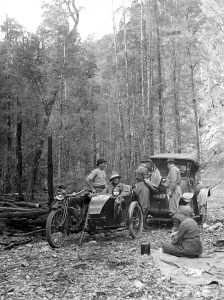
Car trouble for McClinton on the road to the Wolfram mine, Easter 1920, with (left to right) Paddy Hartnett and Fred Smithies helping out; Lucy King ensconced in the Indian sidecar; and either Ida Smithies or Edith McClinton blurred in motion in the foreground. HJ King photo courtesy of Maggie Humphrey.
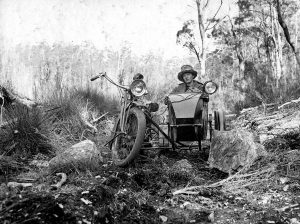
Lucy looking distinctly unimpressed on the road to Pelion at Easter 1920: was it the rough ride or the close attention that dismayed her? HJ King photo courtesy of Maggie Humphrey.
Lucy’s passive role in King’s photos belies that she could not only ride a horse, but was the first Hobart woman to own a motorcycle driver’s licence. She proved her mettle as a walker, too, when at Easter 1920 the Kings visited Pelion Plain and the upper Mersey River, with Fred and Ida Smithies, Ray and Edith McClinton, and Paddy Hartnett as a guide. This was the first time motor vehicles—that is, McClinton’s Chevrolet and King’s Indian—had entered the valley of the upper Forth River. The steep, rutted climb out of Lemonthyme Creek defeated the car until Hartnett cut wooden blocks to support the wheels. The guide also cleared a large tree off the track next day, after the party had spent a night at ‘the Farm’, that is, Mount Pelion Mines’ hut and stables near Gisborne’s Farm. The ‘Bark hut’, 3 km north of the Lone Pine wolfram mine (aka the Wolfram mine), was the terminus for the vehicles. Only Hartnett’s ingenuity and McClinton’s kit bag of cross-cut saw, axe and shovel got them that far. Now they started on foot for the mine and beyond that the Zigzag Track to the copper mine huts at Pelion Plain, a pack horse carrying much of their gear.[5] Lucy recalled walking
‘eight miles in the pouring rain and when he reached the hut at the top nobody had a dry stitch. Fortunately for the ladies there were two trappers there, and they obligingly said, ‘You come into the hut where this fire is, and get yourselves dried out, and the men will go to the other hut and make a fire for the same purpose’. The next morning when we woke up it was one of the most beautiful sights that was possible. There wasn’t a blade of grass that wasn’t covered in snow’.[6]
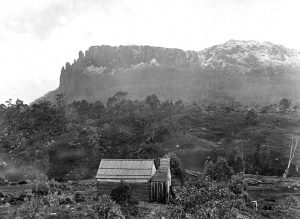
Mount Oakleigh and Old Pelion Hut, still with their dusting of snow, Easter 1920. HJ King photo courtesy of Maggie Humphrey.
That view included Mount Oakleigh, which Herb King photographed. Members of the party visited Lake Ayr and the head of the Forth River Gorge before starting on the return journey.[7]
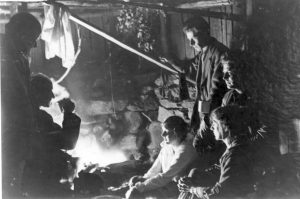
‘The huntsman’s story’, taken in the mine workers’ hut at Pelion Plain, with (left to right) Ray McClinton, Paddy Hartnett, Lucy King, HJ King, Ida Smithies and Fred Smithies. HJ King photo courtesy of Maggie Humphrey.
Although Paddy Hartnett never used the media, he was equally significant as Weindorfer in the development of a Cradle Mountain‒Lake St Clair National Park. Hartnett’s Du Cane Hut, also known as Cathedral Farm and Windsor Castle, was effectively his Waldheim, a tourist chalet among the mountains. King’s treks to Cradle Mountain and Pelion with their respective guides were transformational in the sense that, although he never became a hardened bushwalker like his fellow photographers Spurling, Smithies and McClinton, he did become a promoter of the Cradle Mountain-Lake St Clair National Park proposal. McClinton photos from this trip appeared in the Weekly Courier, and he, Smithies and King lantern lectured about the proposal.[8]
A slide survives of King promoting himself as a nature photographer, suggesting that he toyed with the idea of turning professional. Presumably, he decided it would not pay. The Kings were a very conservative family. His grandmother, said to be the first Christadelphian in Tasmania, was reputedly disgusted by King’s spending on photographic materials. Perhaps family influenced his choice of career. It is possible that the family motorcycle business seemed a safer bet, or that he felt obliged to follow in his father’s footsteps. Ultimately, people, family and faith meant more to King than any machine or any gadget. It was probably not just for artistic purposes—the compositional need for a foreground—that he placed Lucy in so many of his images. It signalled that she was foremost in his thinking.
[1] See, for example, Sim King advert, Examiner, 2 July 1921, p.14.
[2] Lucy King, transcript of an interview by Ross Case, 18 March 1993, OH18 (Queen Victoria Museum and Art Gallery [hereafter QVMAG]).
[3] Lucy King, transcript of an interview by Ross Case, 18 March 1993, OH18 (QVMAG).
[4] HJ King, ‘A flight to the Cradle Mountain’, Weekly Courier Christmas Annual, 3 November 1932, p.12.
[5] ‘Motors, cycles and push bikes’, Daily Telegraph, 17 April 1920, p.5.
[6] Lucy King, transcript of an interview by Ross Case, 18 March 1993, OH18 (QVMAG).
[7] ‘Motors, cycles and push bikes’, Daily Telegraph, 17 April 1920, p.5.
[8] See Weekly Courier, 15 July 1920, p.24. McClinton’s photos of the Easter 1920 trip with the Kings, Smithies and Hartnett was used here to illustrate part one of George Perrin’s account of a January 1920 trip into the same country with his wife, Florence Perrin, their friend Charlie MacFarlane and Hartnett (‘Trip to Tasmania’s highest tableland’, Weekly Courier, 8 July 1920, p.37).













































